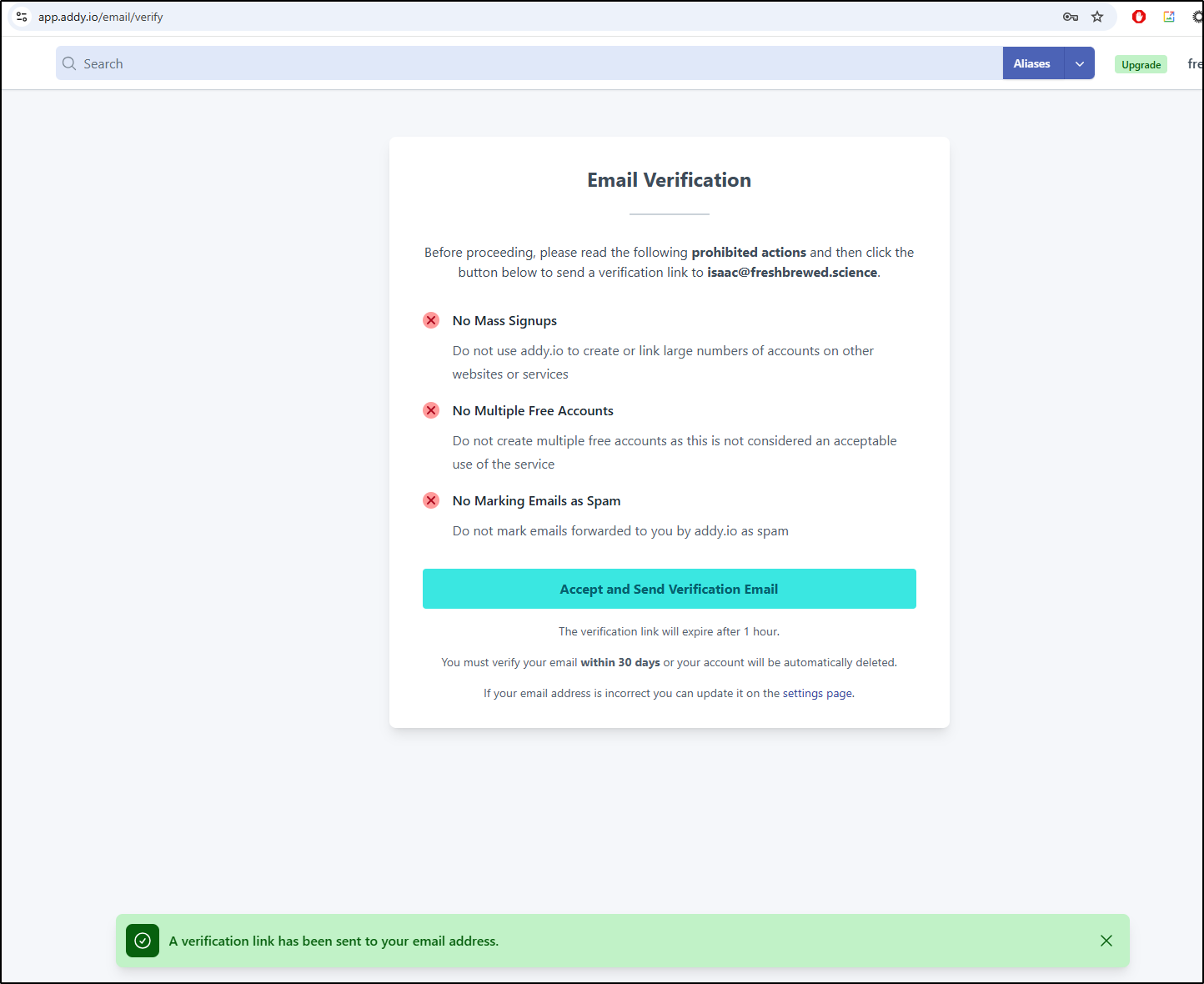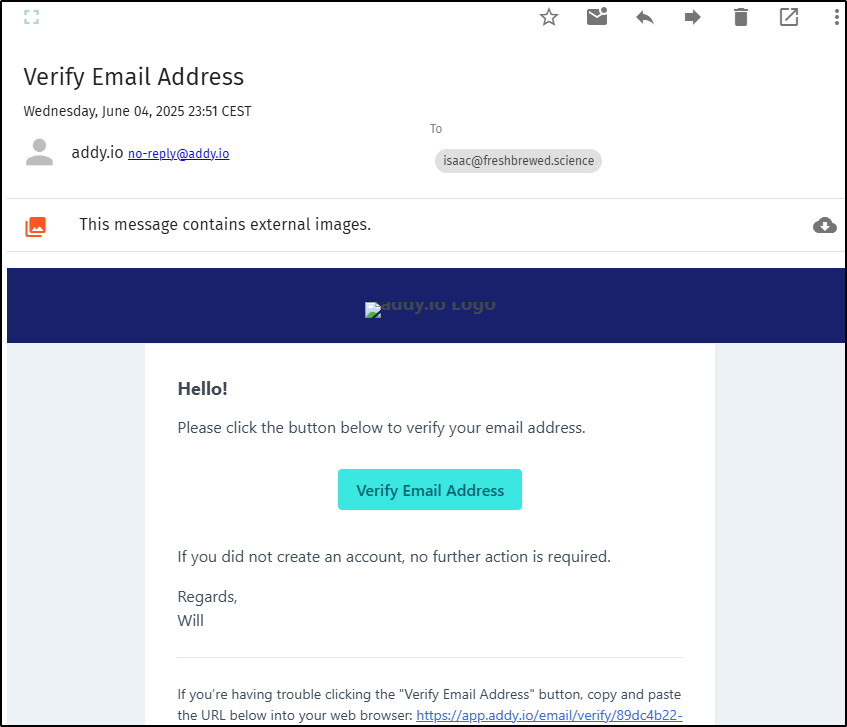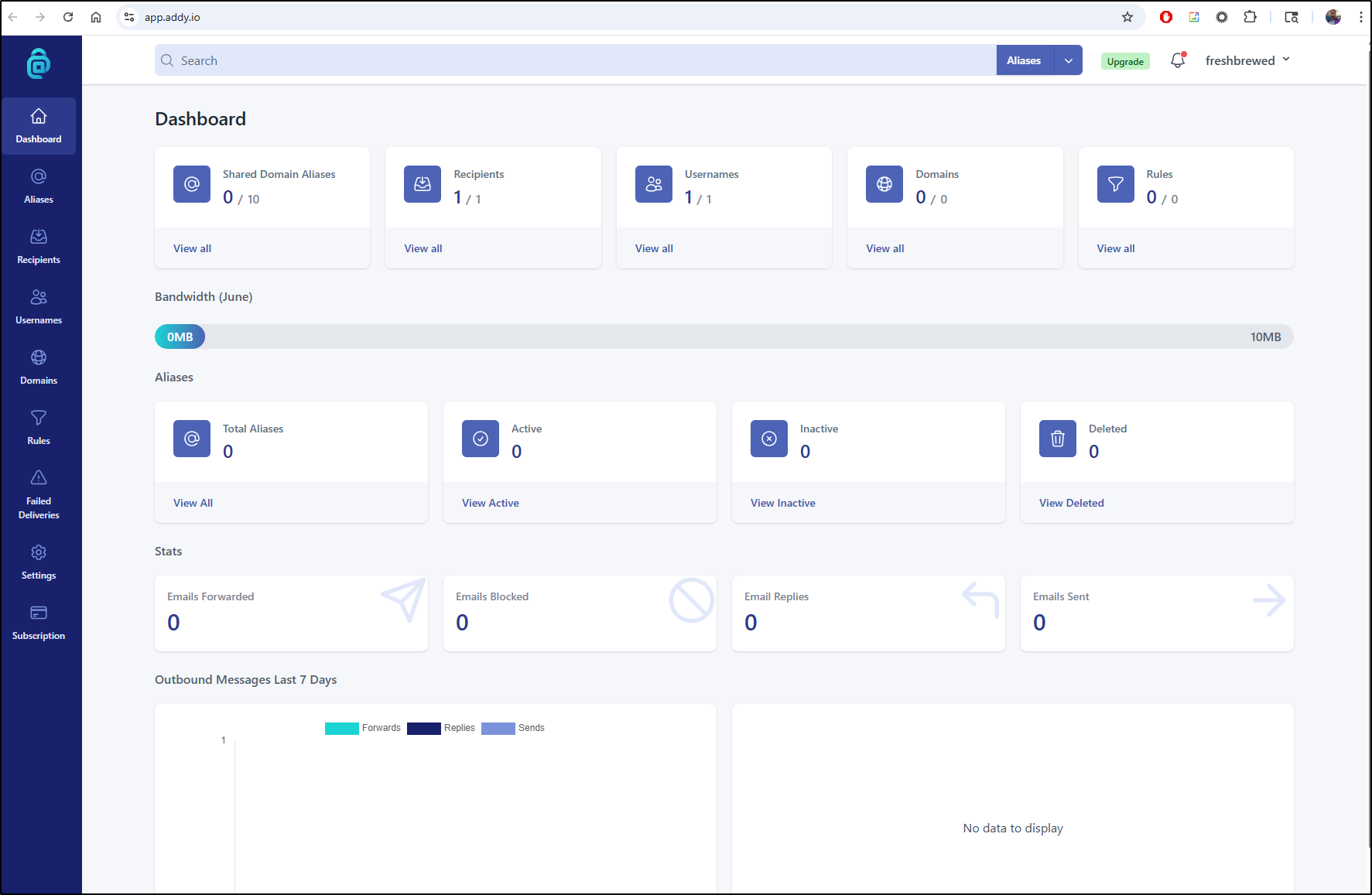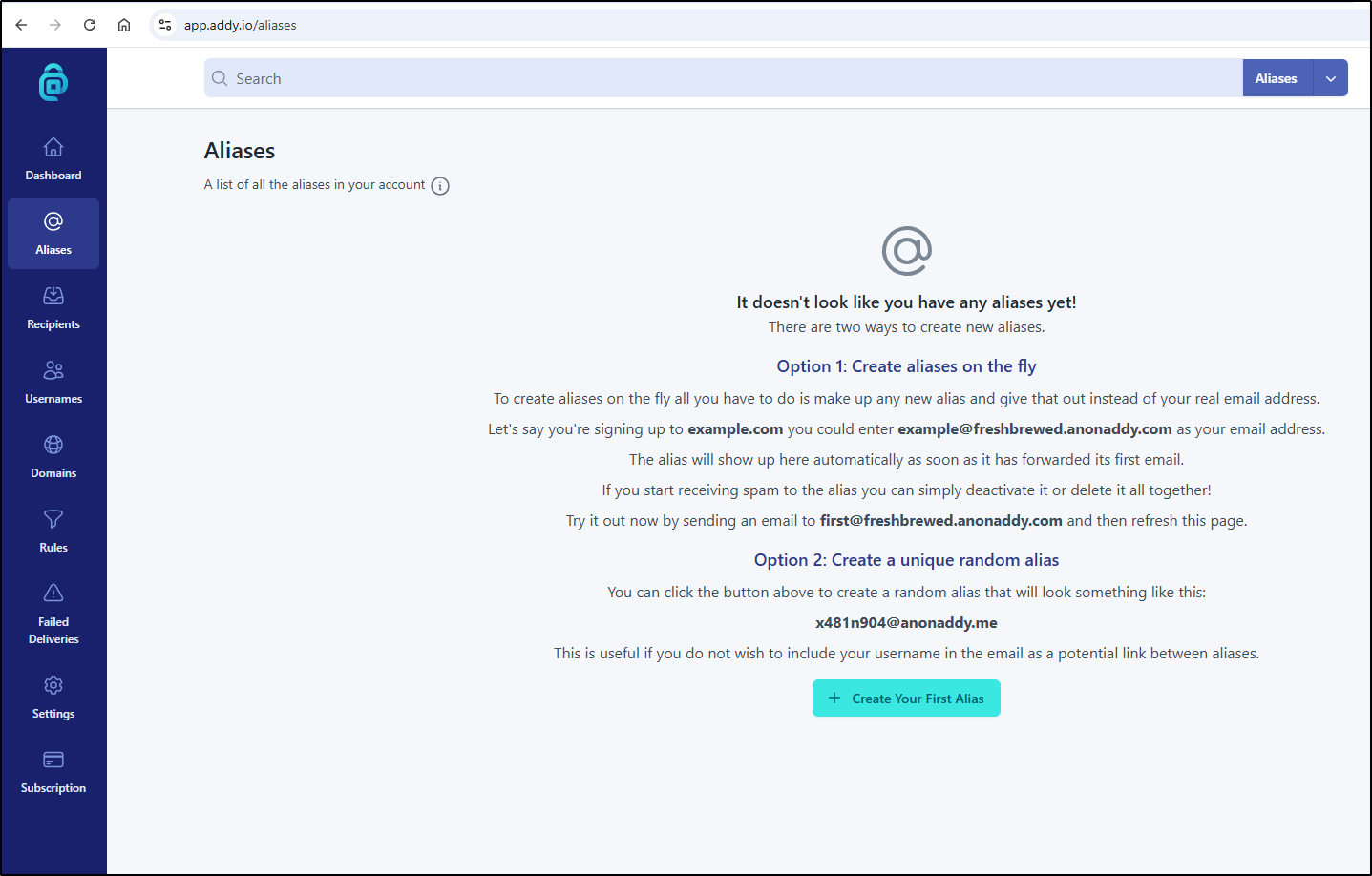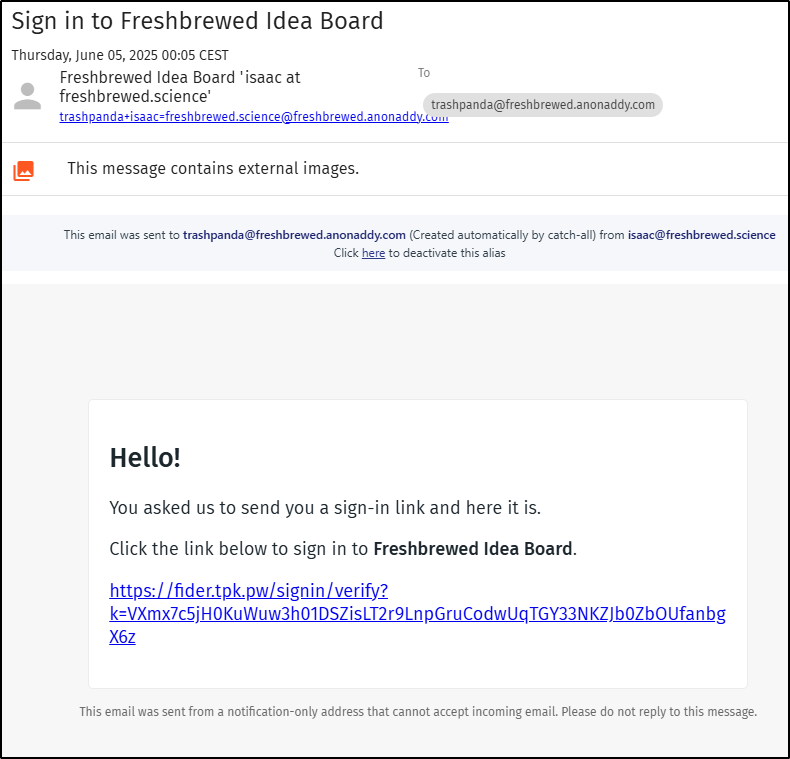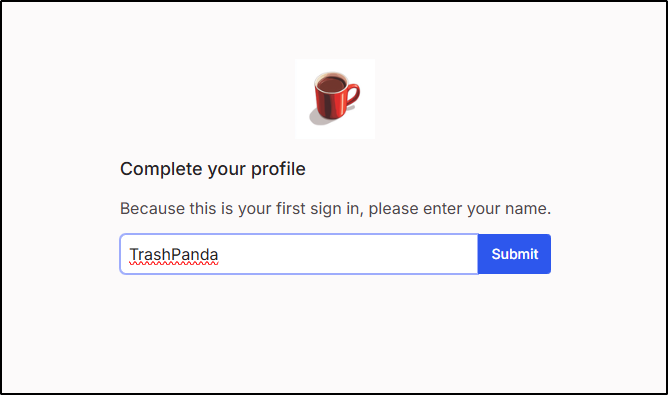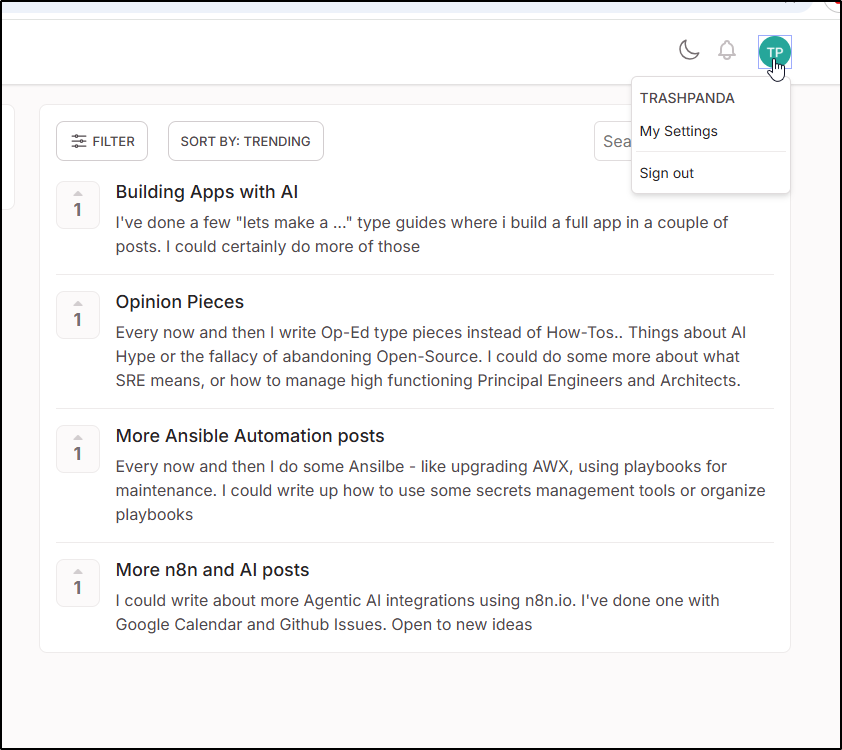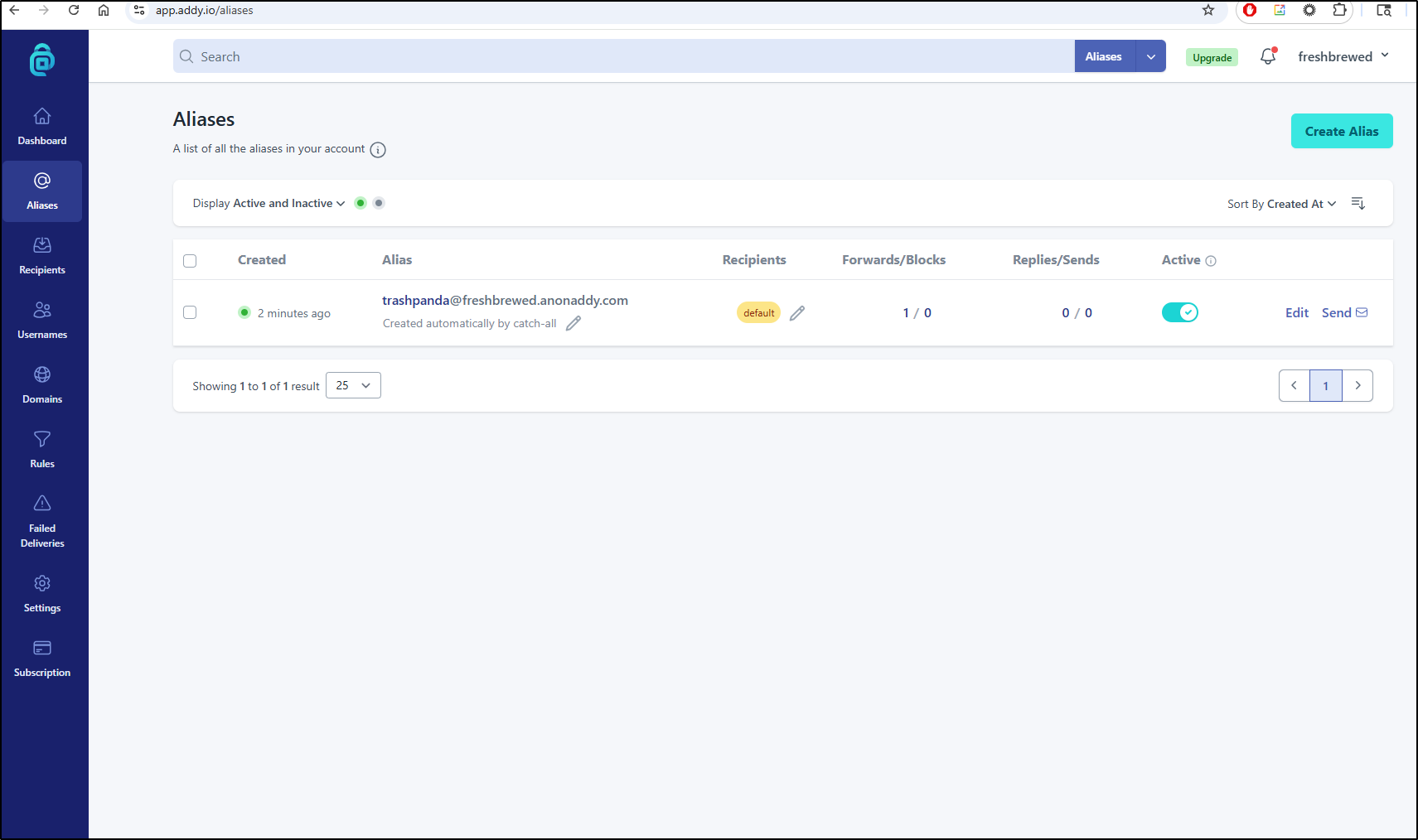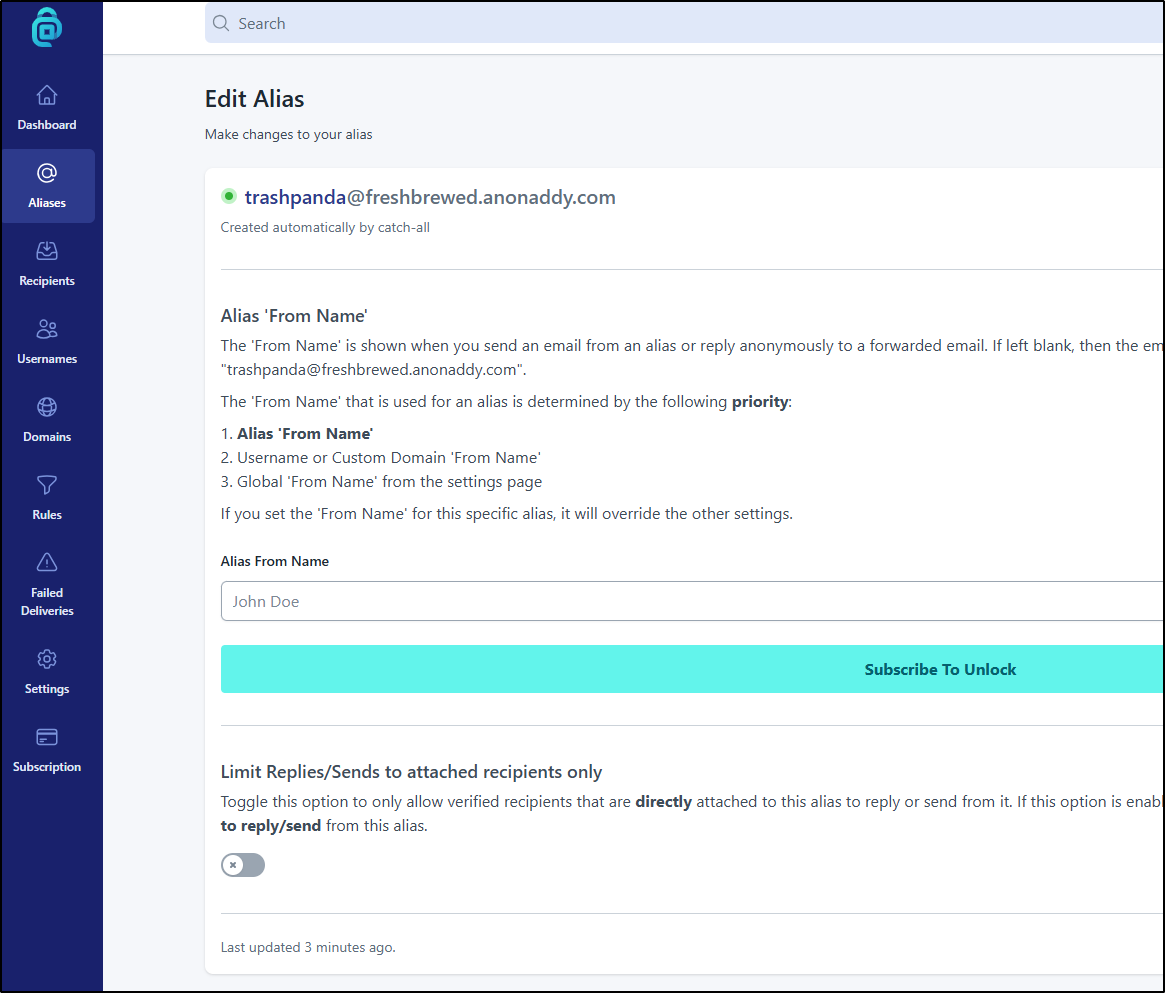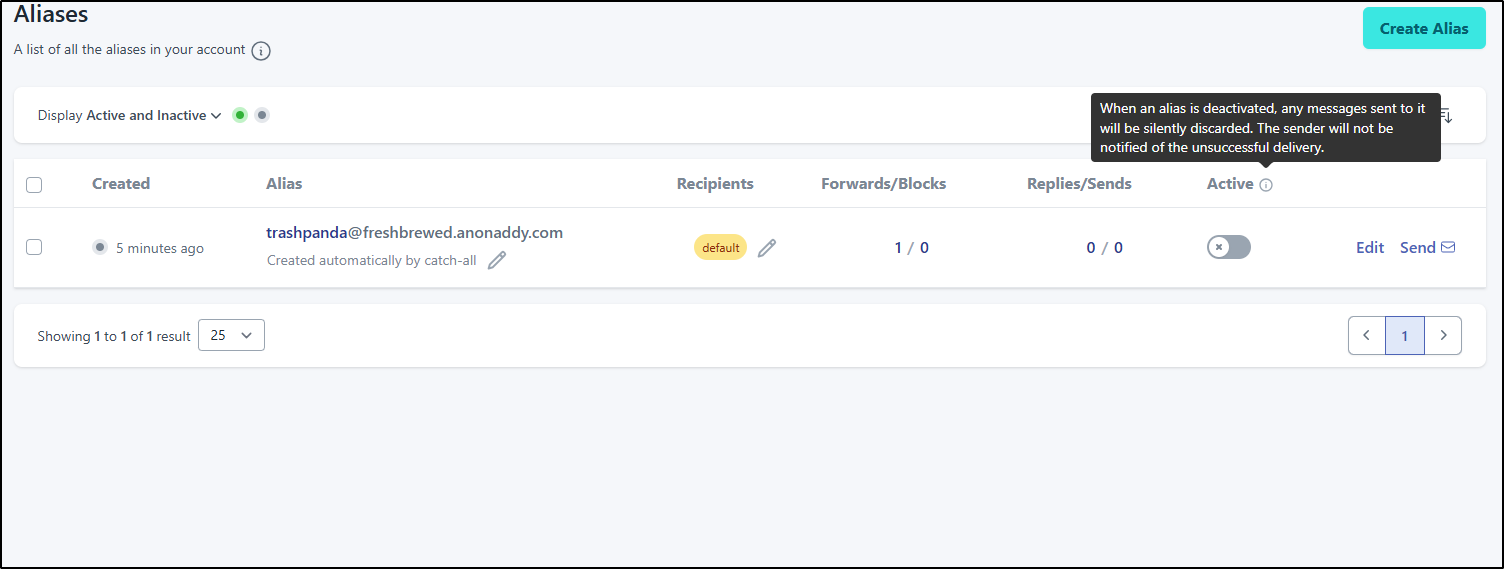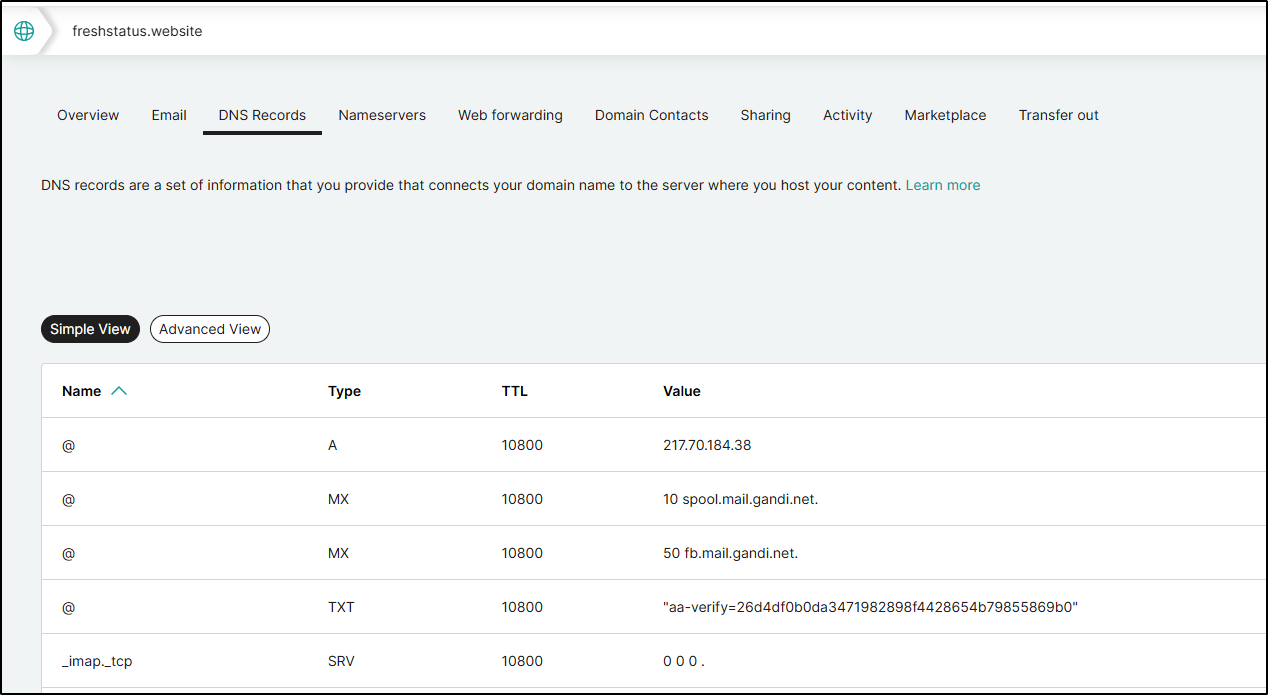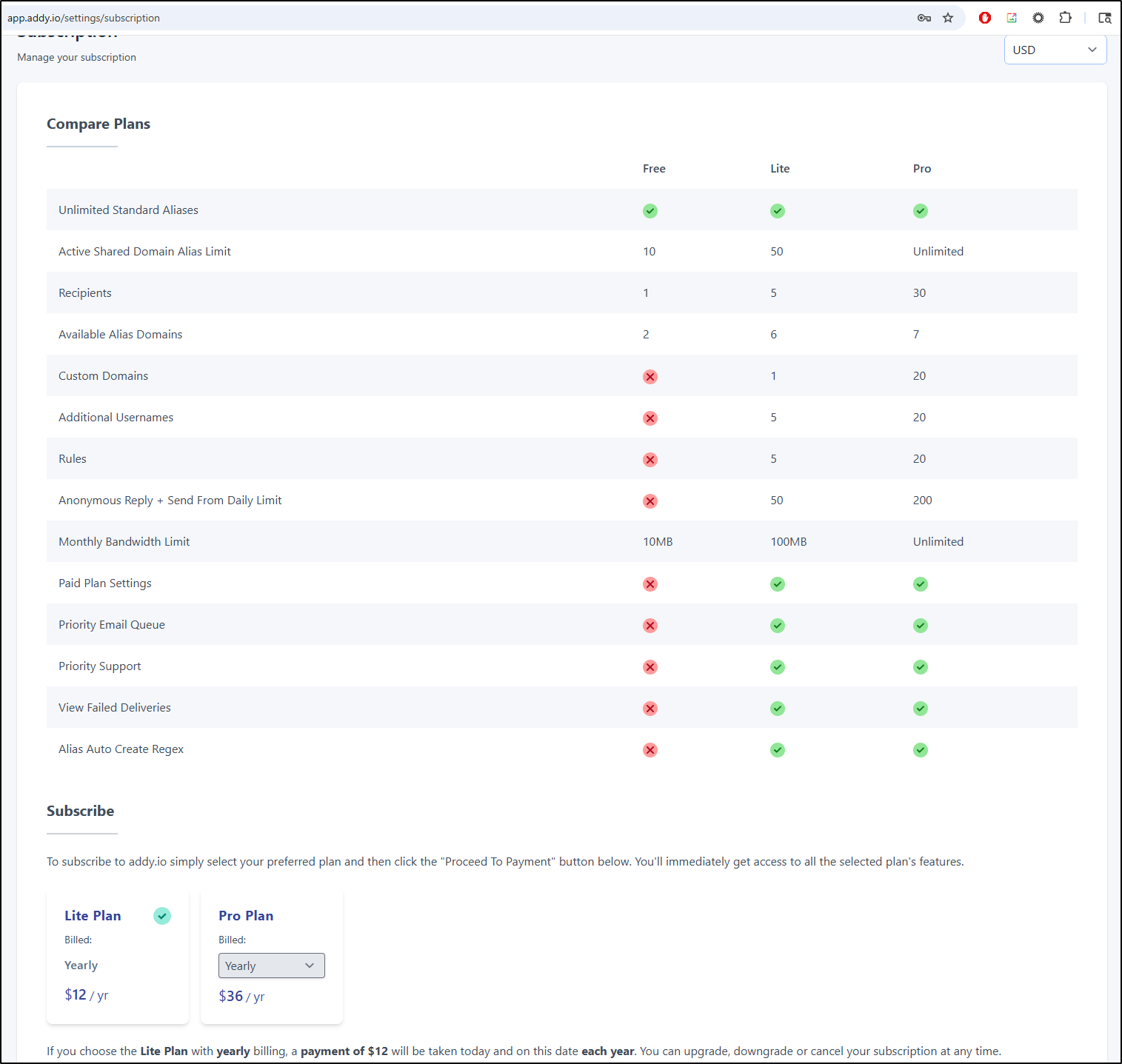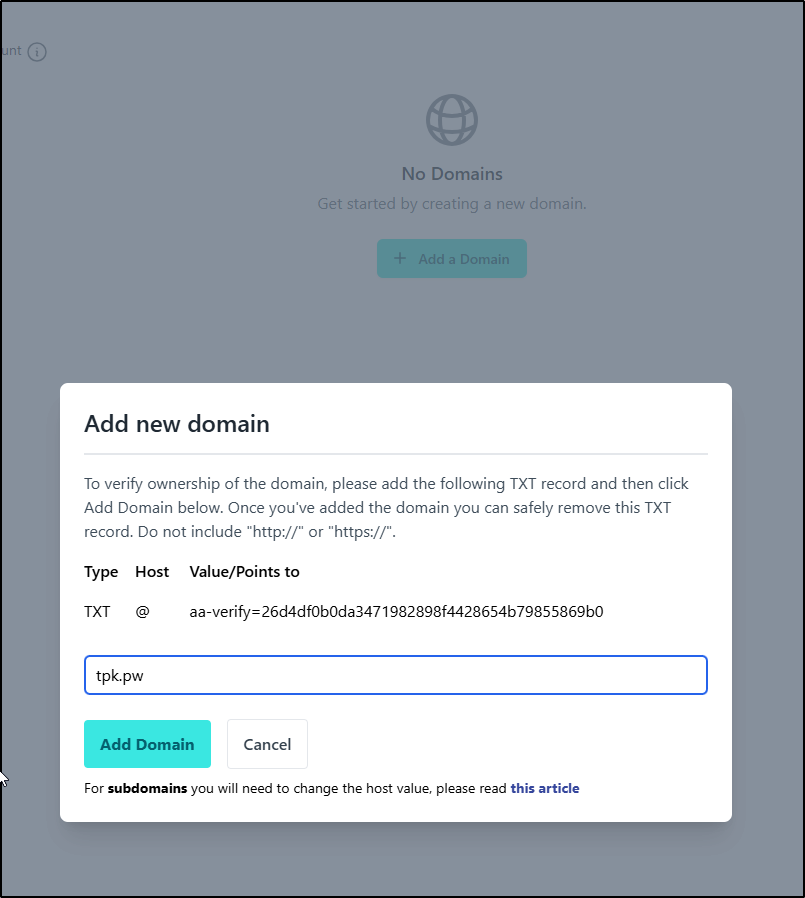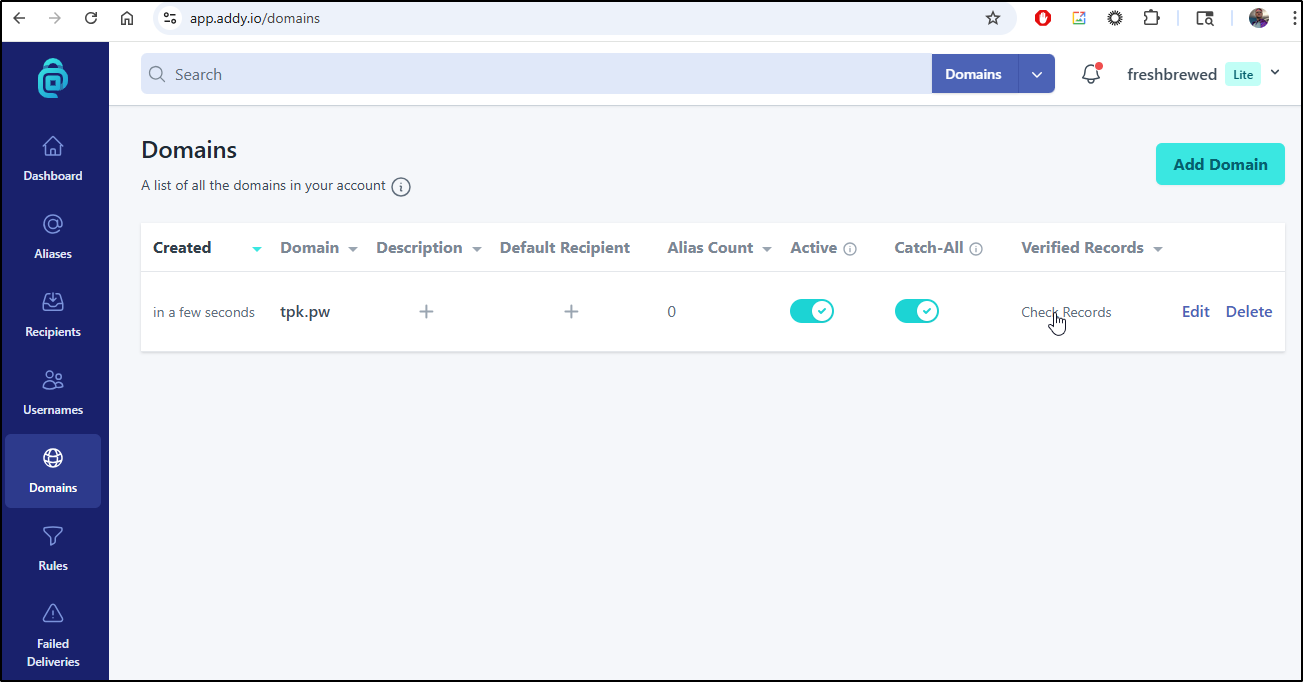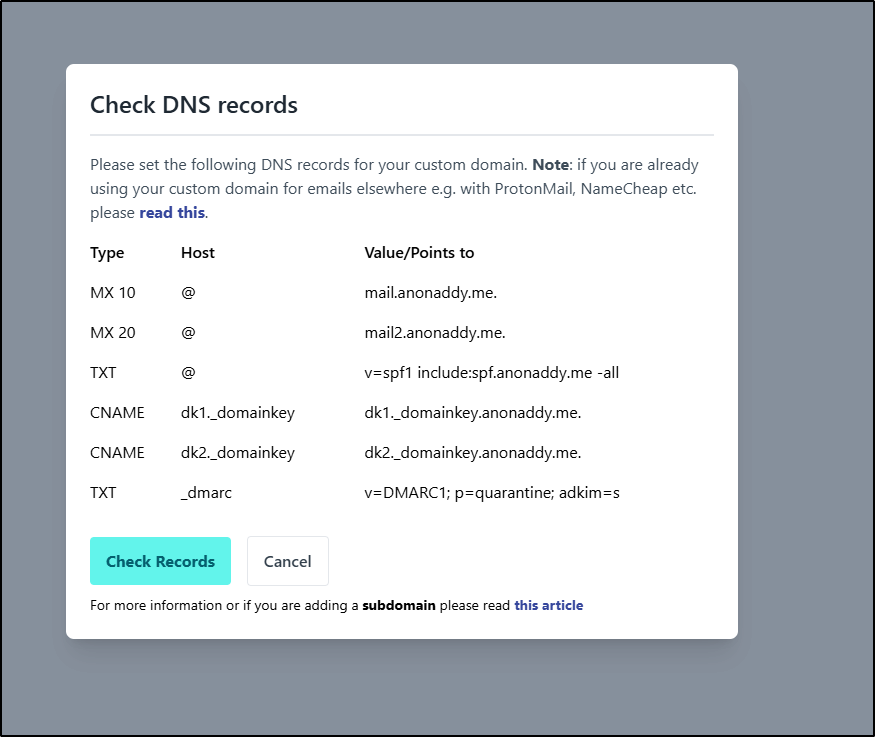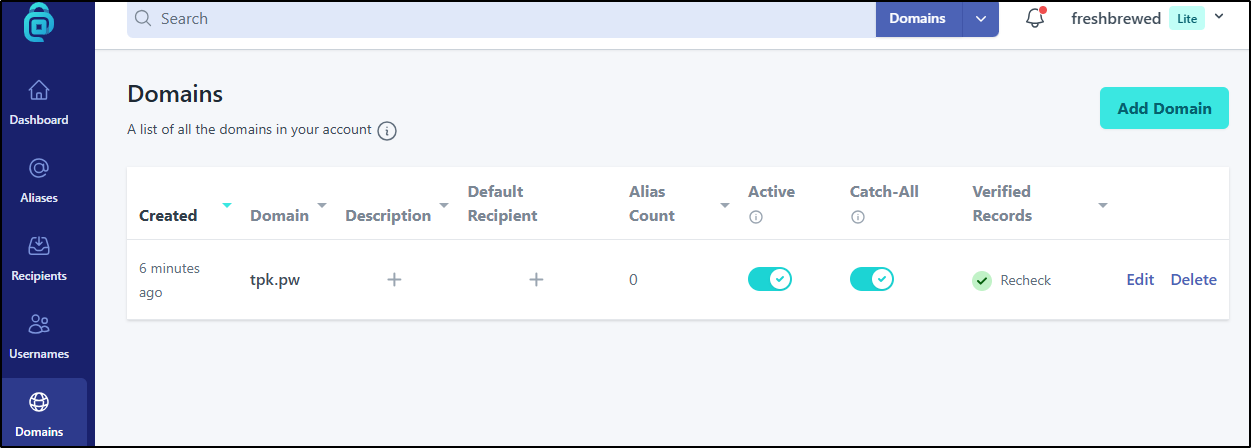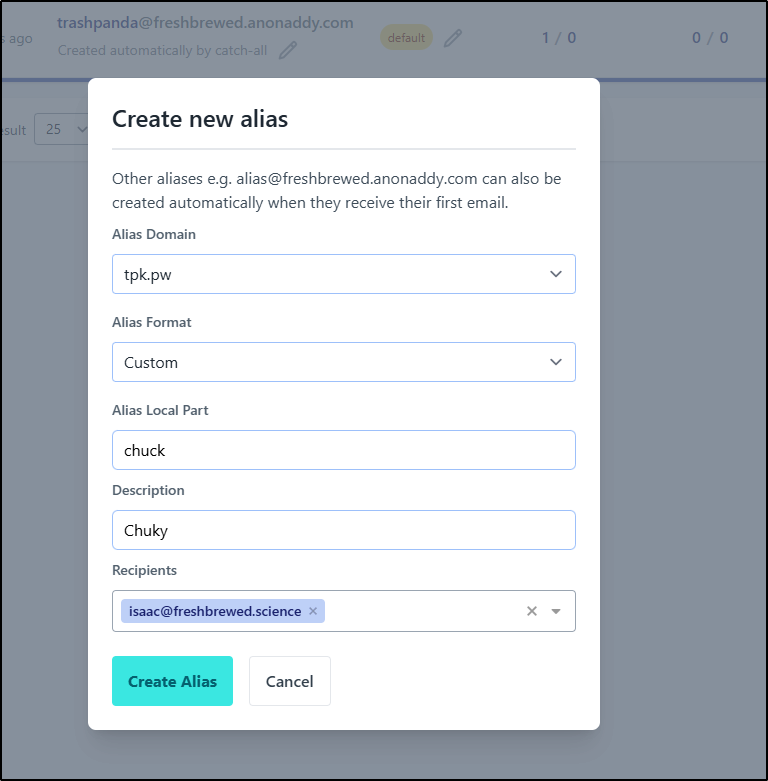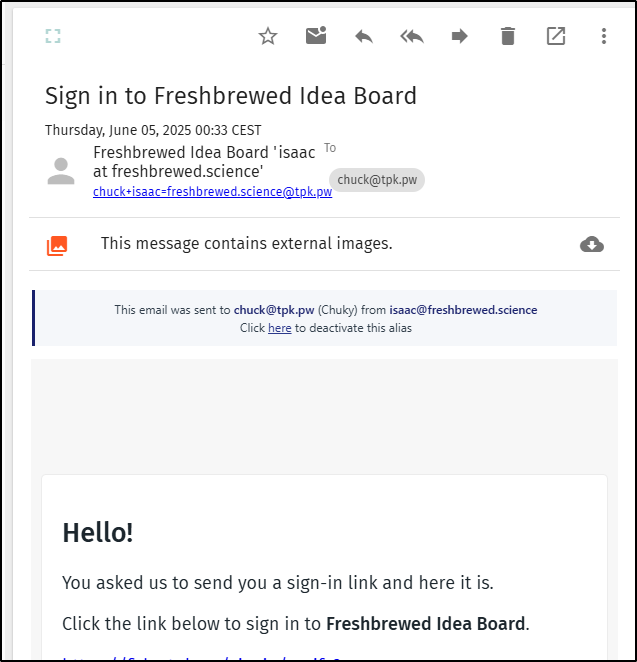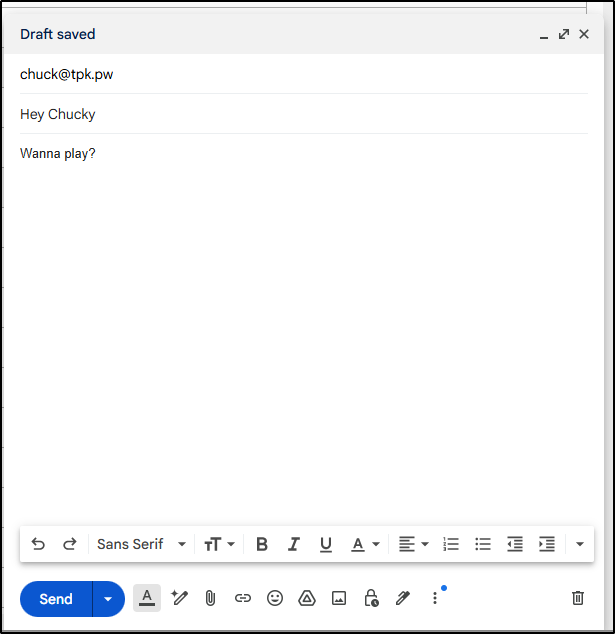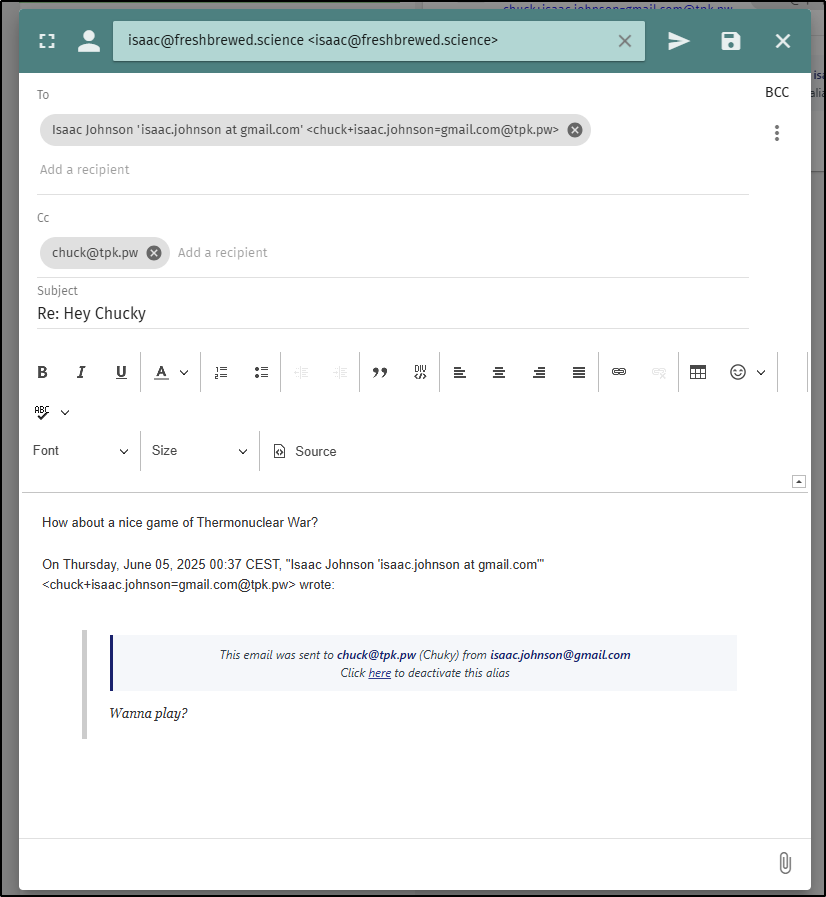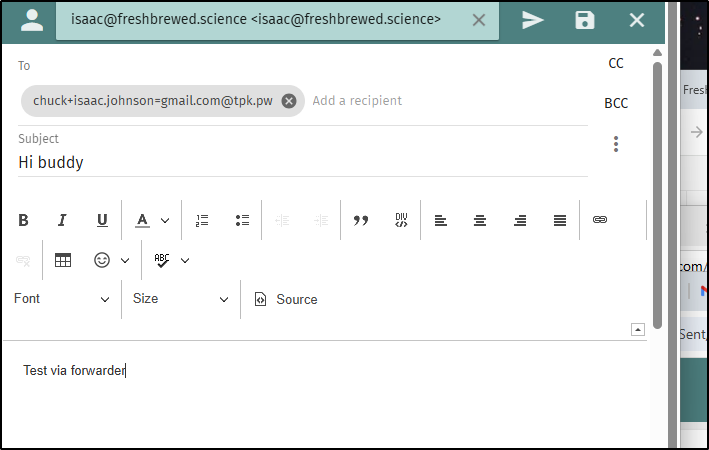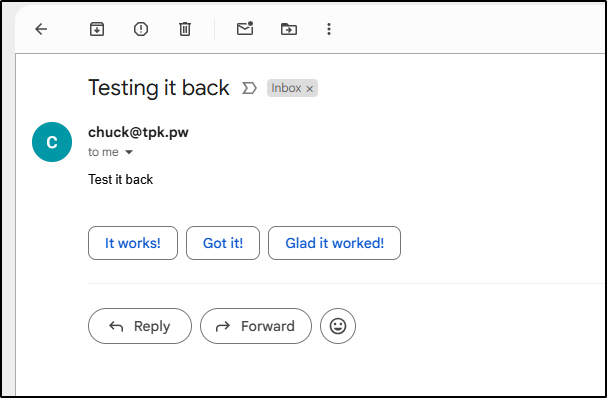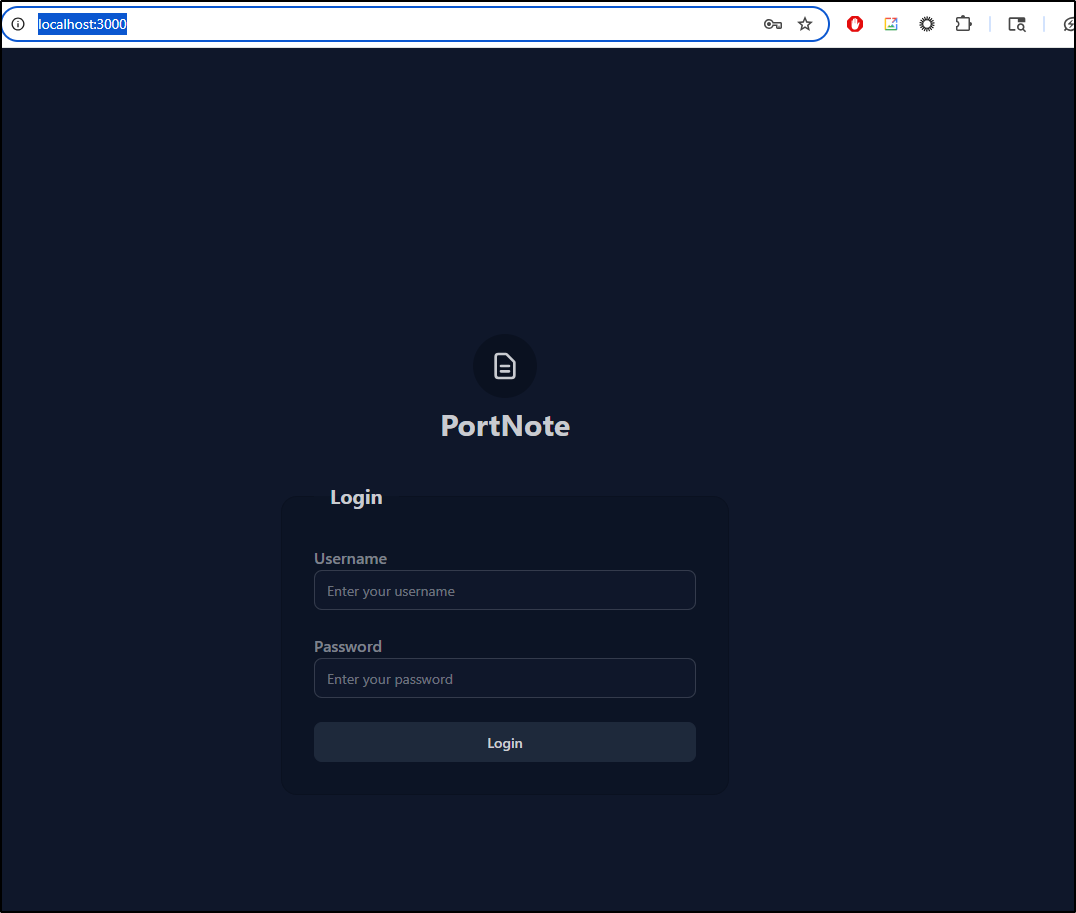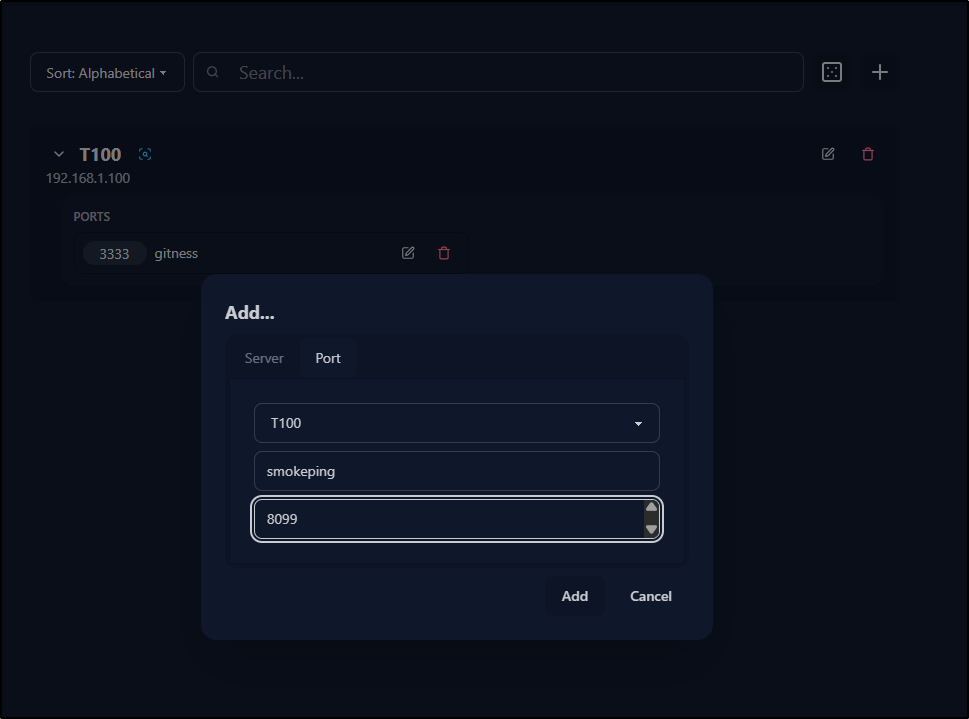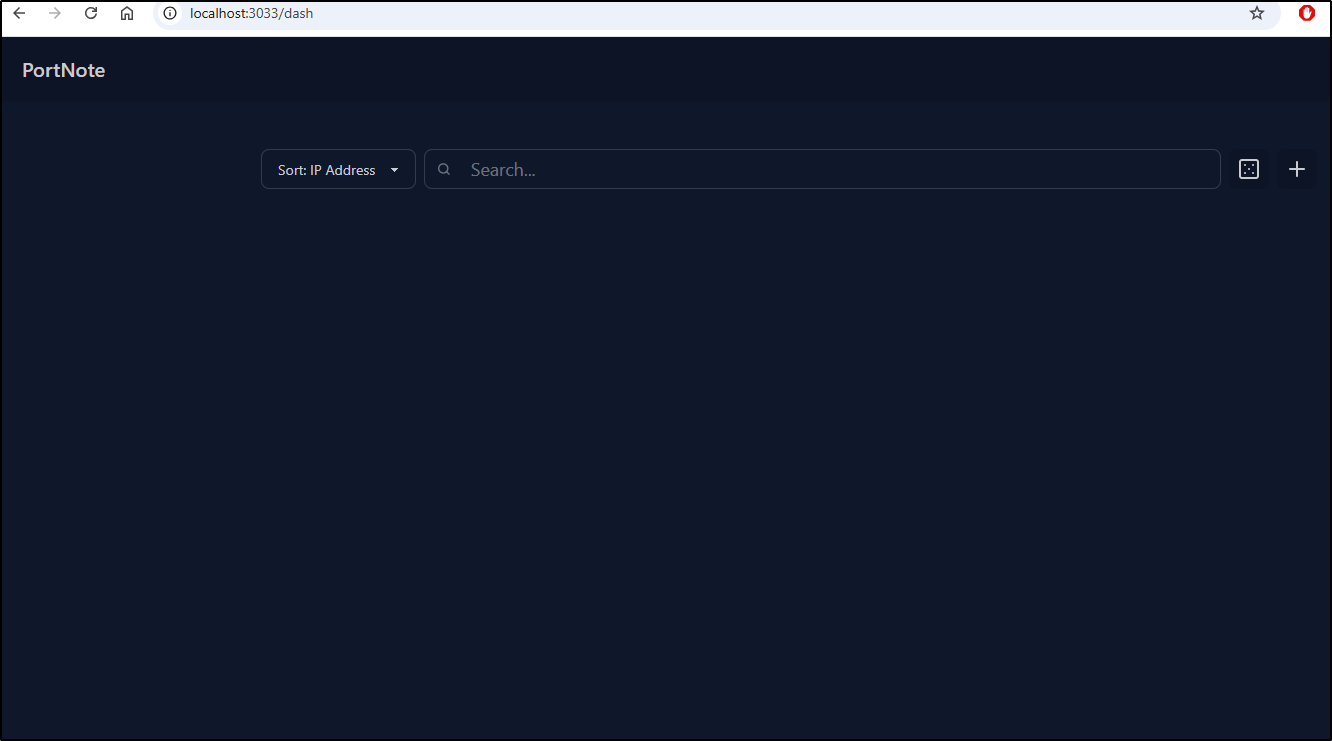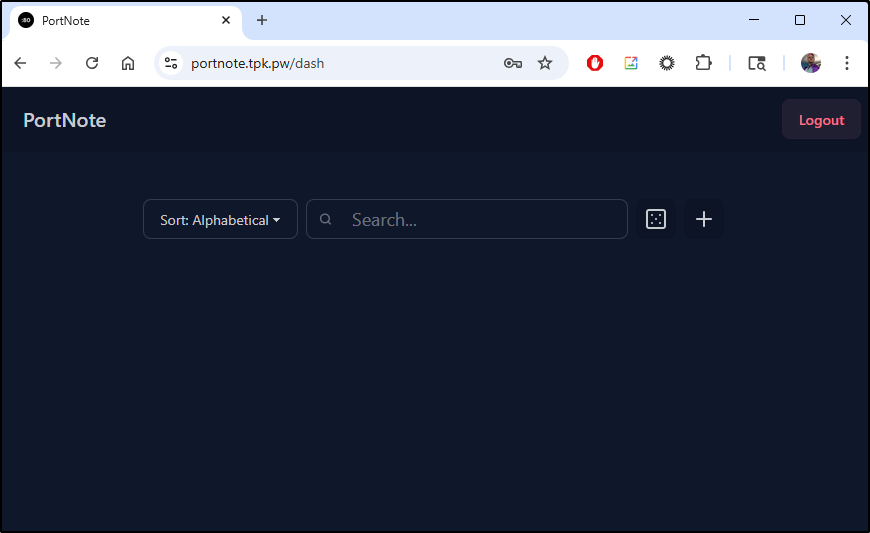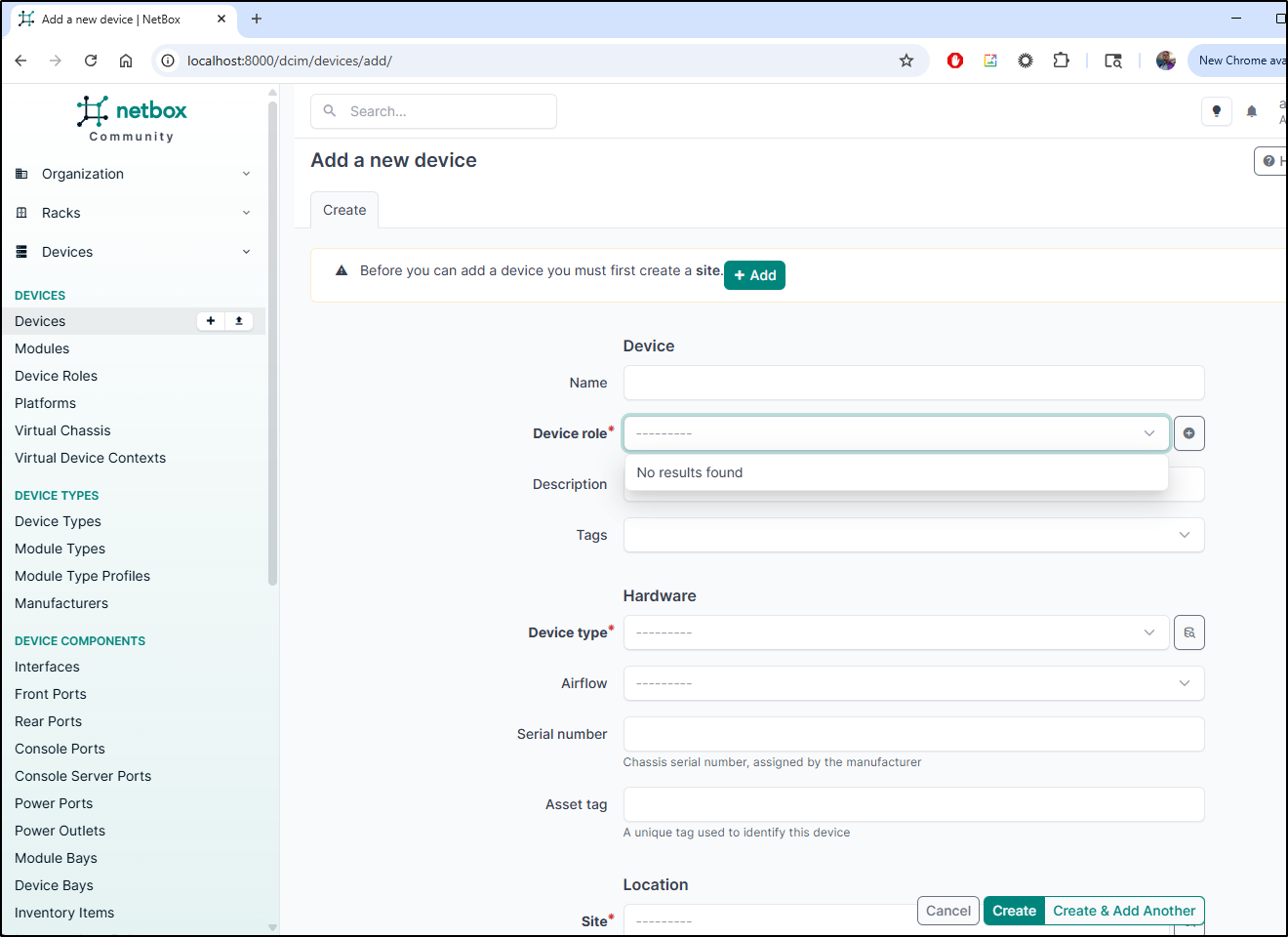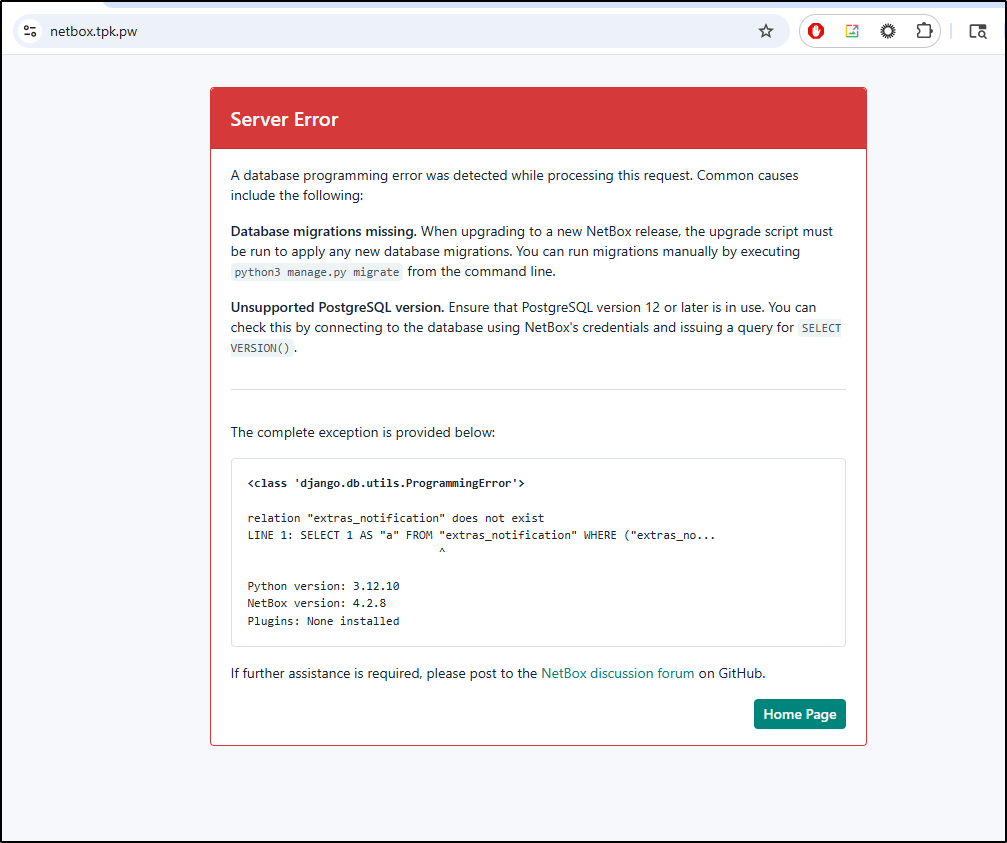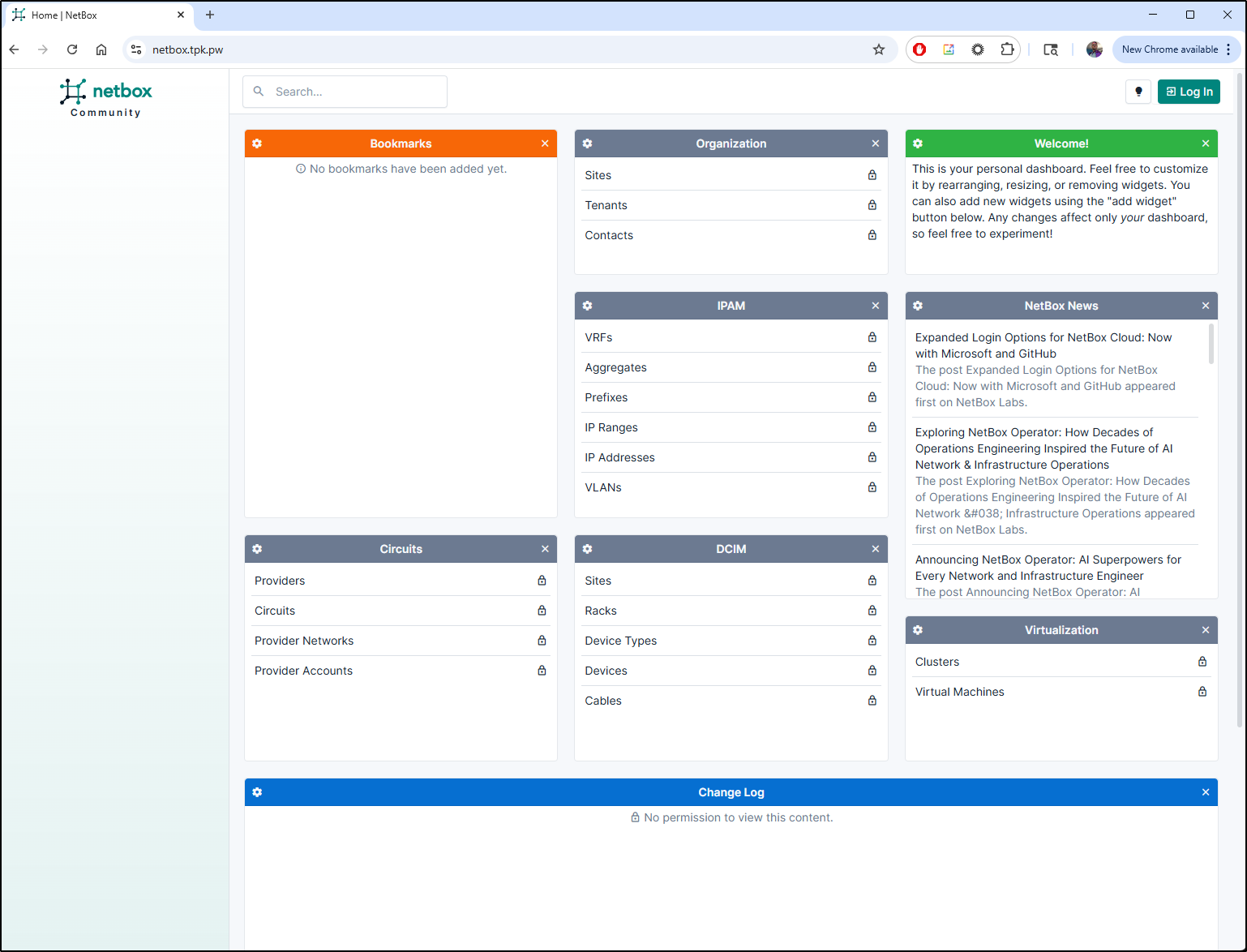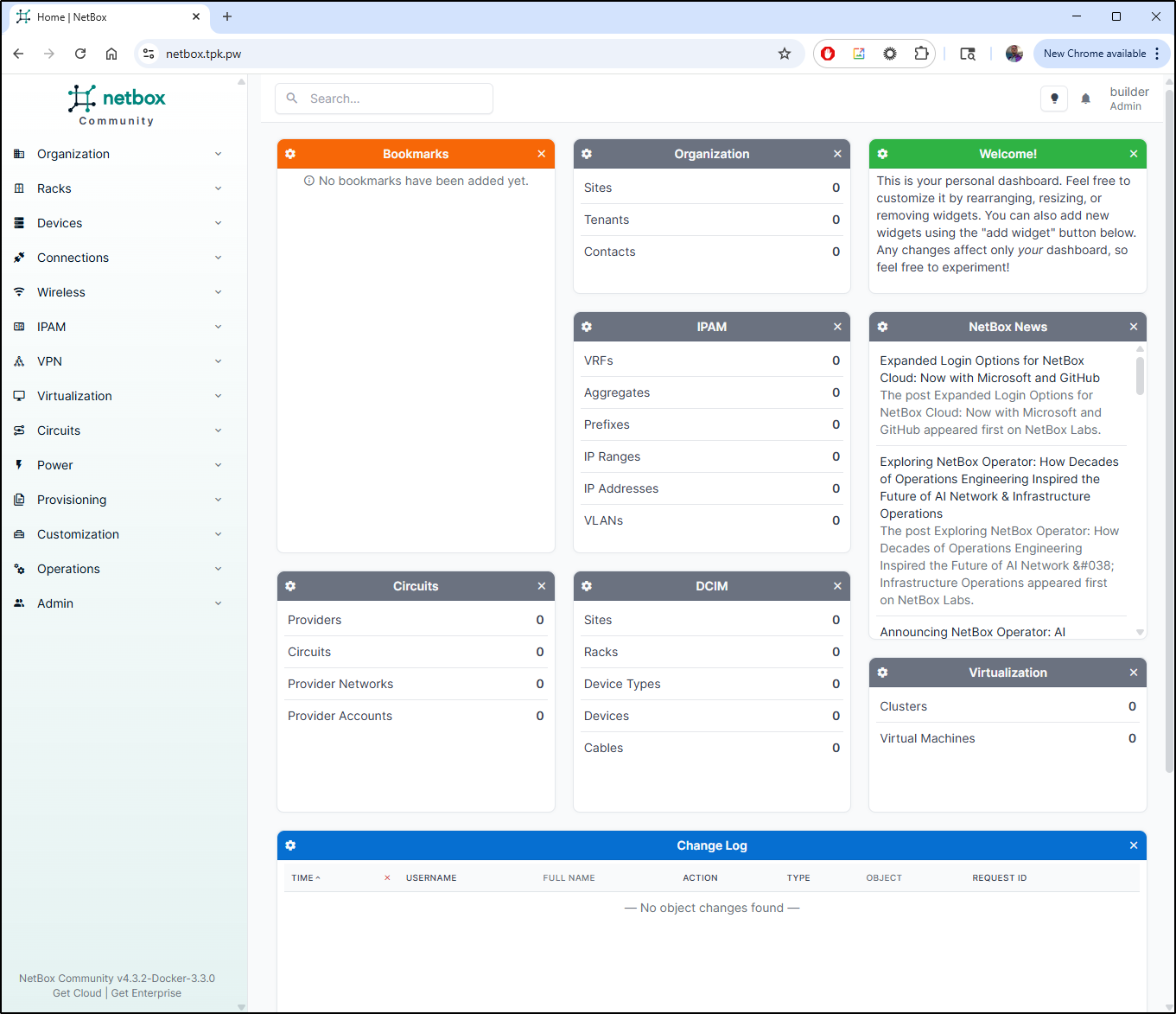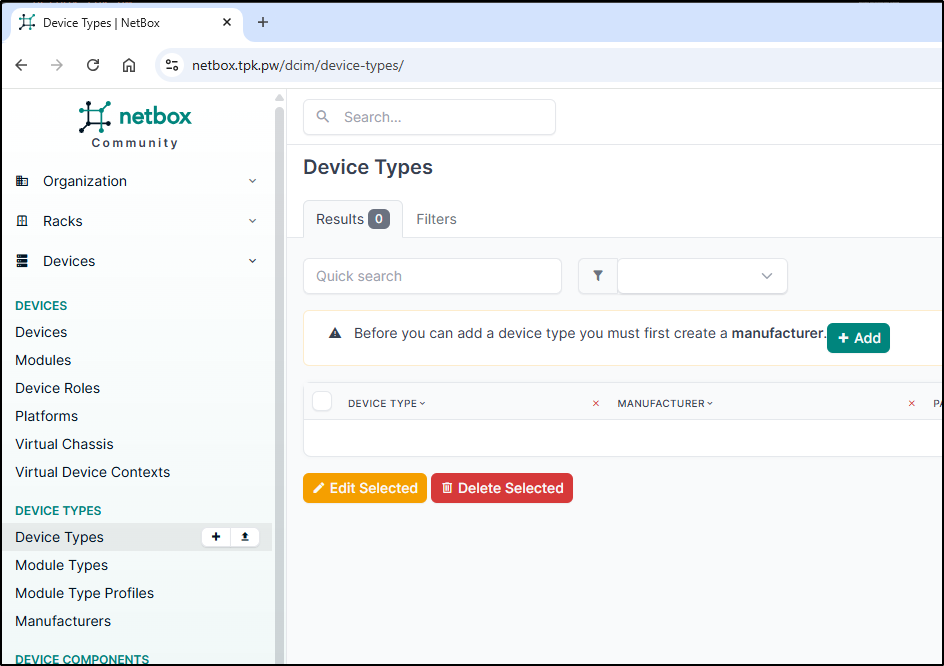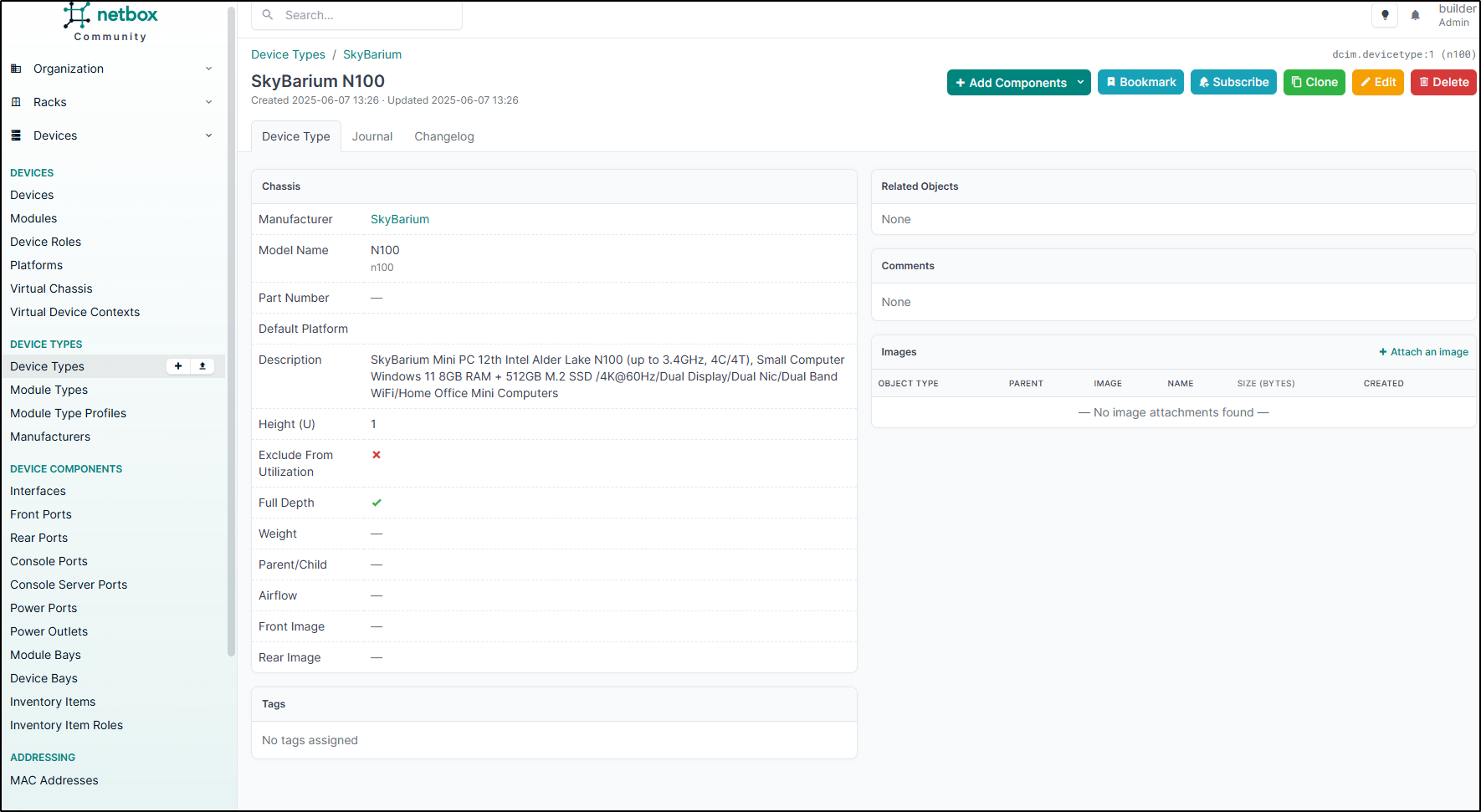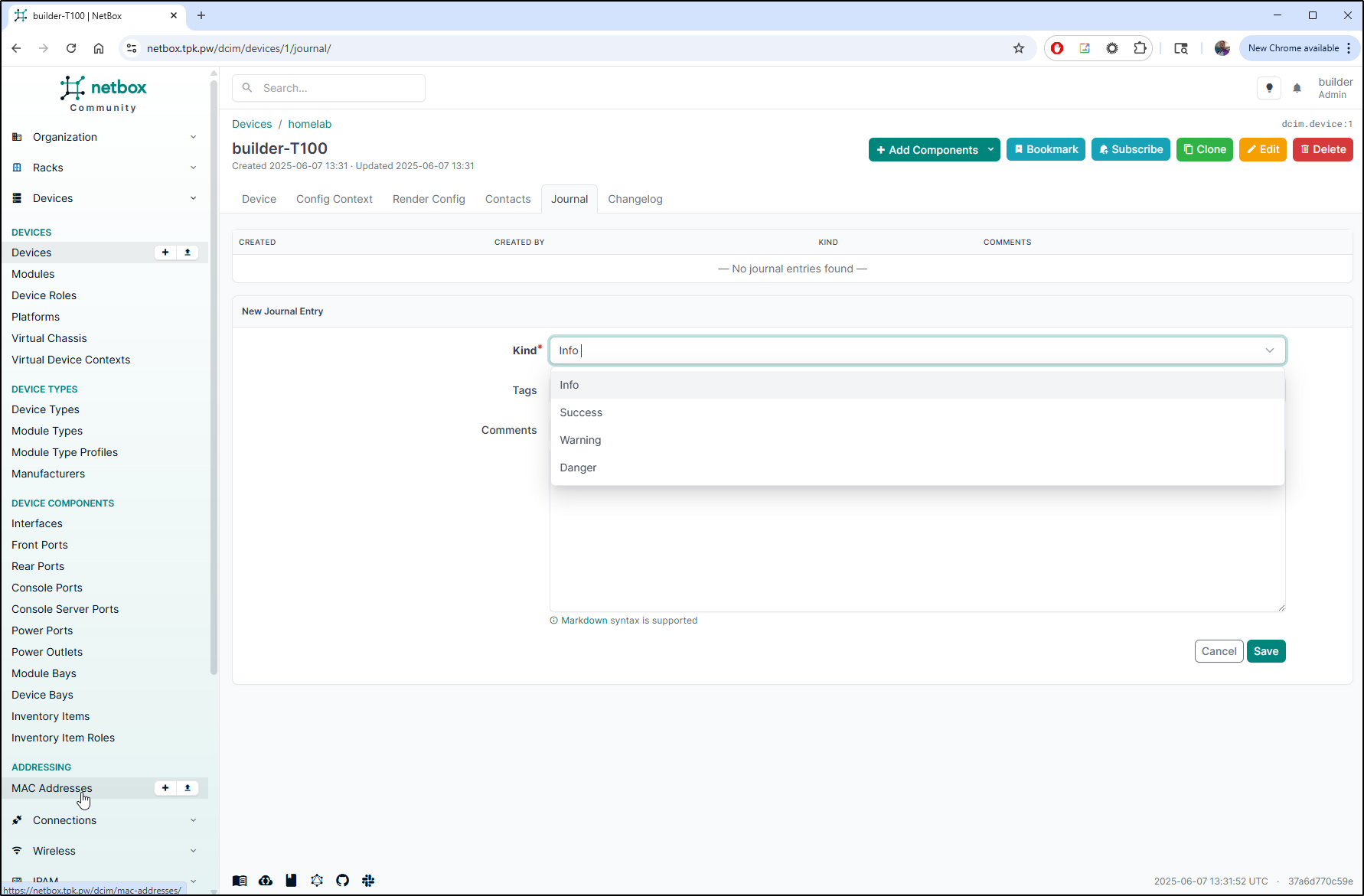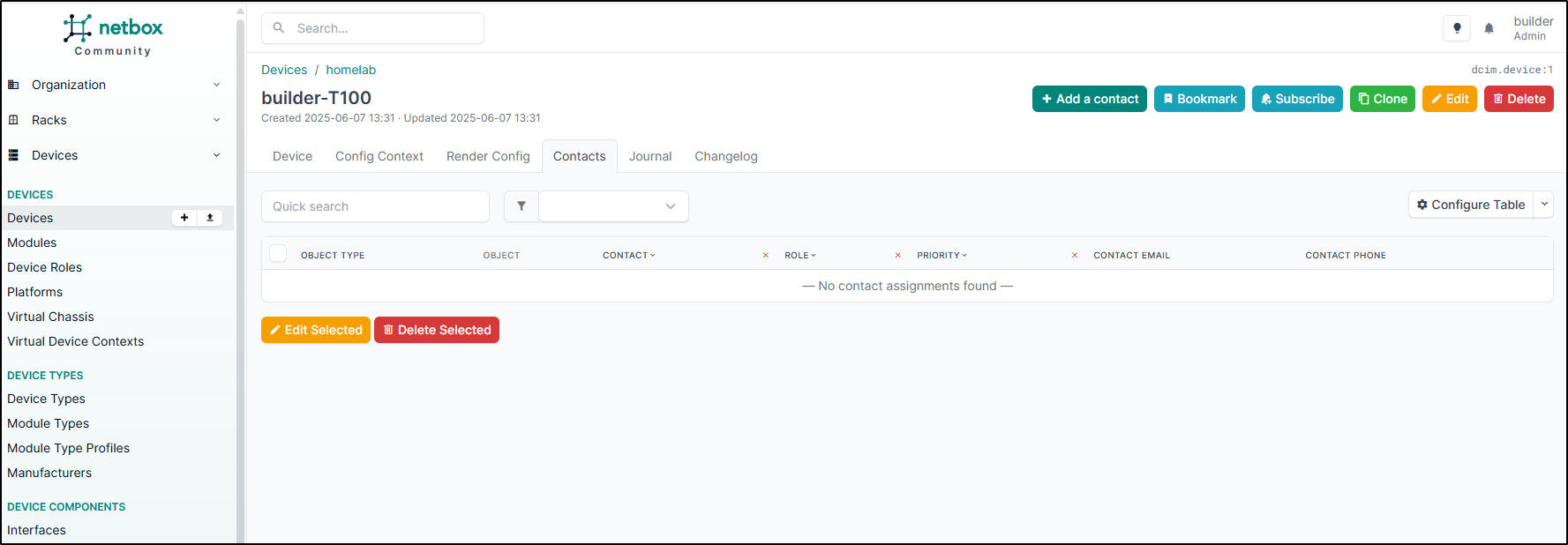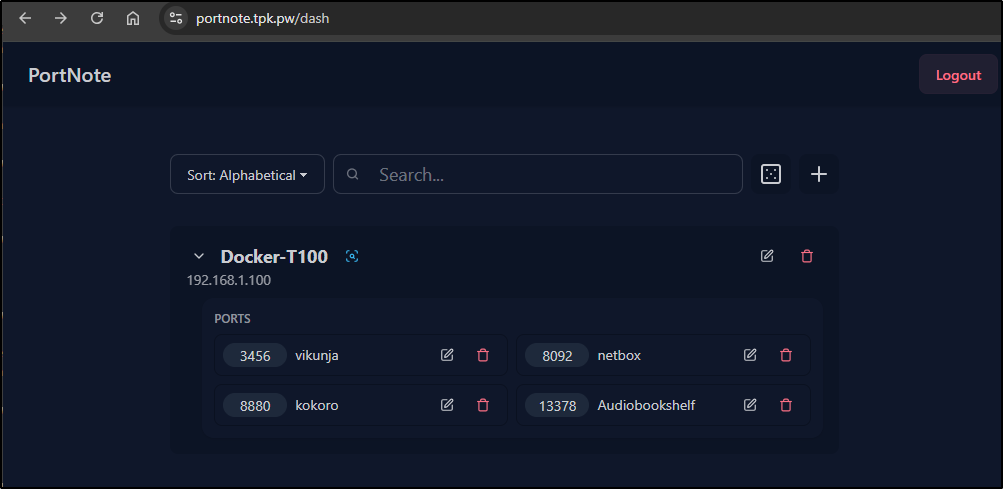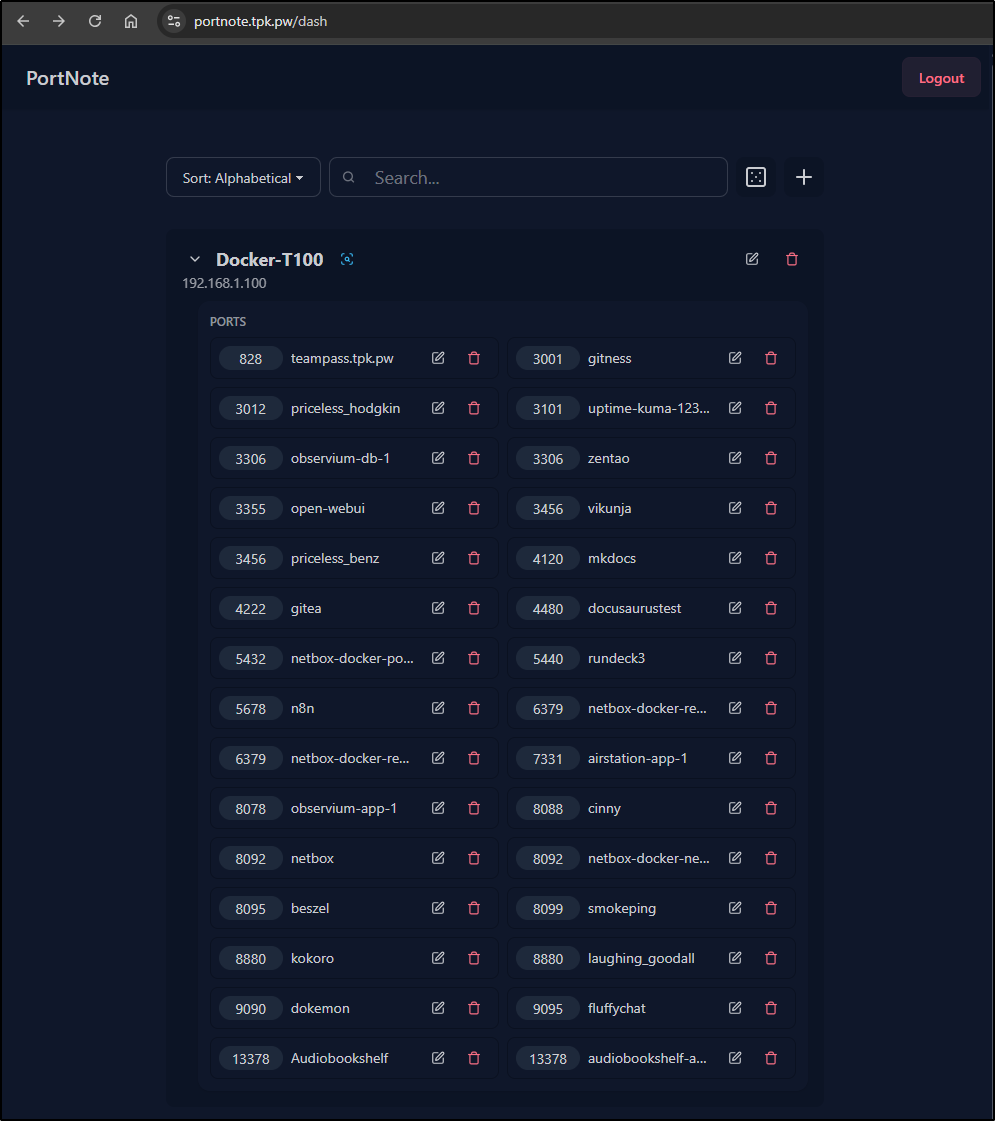Published: Jun 10, 2025 by Isaac Johnson
addy.io is basically an anonymous email forwarding service based on an open-source platform we can install locally. I’ll focus on the free tier and lowest end paid tier of their SaaS offering showing how we can configure our own domain for email forwarding.
The second half of this article focuses on ways to track ports and hosts in a homelab. Based on this Mariushosting post on PortNote, I’ll dig into host in docker and Kubernetes then compare to another NOC / Operations platform, NetBox.
Lastly, I’ll wrap with some automation tips for PortNote which make it stay always up to date.
Addy
I’m not sure how I even came across addy.io. It was scribbled in my notes with just the URL.
Addy is simple: anonymous email forwarding. It is Open Source and one can self-host. However, for this test, I’ll just work with their free SaaS offering.
I’ll have to verify my destination email
with the link they sent
I now see the addy dashboard
Aliases
We can create a top level one with a random string, or use any name under our own subdomain
I’ll try using trashpanda@freshbrewed.anonaddy.com to start. Perhaps we wish to game the voting page
which sends a confirmation email
I can see it forwarded
Which then let me create a user in Fider
And now I could vote if I wanted
Back in Aliases we can see the new alias that was used
If we click “edit” on the alias we can see our first pay feature - custom Alias From Name
Now, if we want to stop using it, we need to deactivate it. By setting it to not active, it will throw out future spam messages
Custom Domains
We could do custom domains by taking the aa-verify
and setting them in our DNS records
but as that is another paid feature, I won’t be able to test it
I’m seriously considering buying this because the lite plan, which would cover my needs, is just a mere US $12/y
Dammit… I couldn’t resist. I got the Lite version
I’ll add the verify record to Azure DNS, in this case, for tpk.pw
Then we can set it back in addy.io
Since I already added the TXT record, I can ask Addy to verify now
Actually, looks like I have a few more to set
Once updated, we can see it show verified
Now I can use my domain in an alias
And indeed, that worked!
Now, this will be handy for the types of services that have crappy regexp’s on their email forms and block “.science” as it’s too long (in their eyes).
I want to test the flow from emails. I’ll try sending an email from my gmail
I then replied
However, I found the replies did not get back to my gmail.
I then tried using a forwarder email
I have some kind of DMARC issue still with freshbrewed.science blocking things, but I set the whole flow from GMail and managed to get it working
So I’ll have to come back and sort out whatever DMARC issue is hanging out fb.s emails
PortNote
A while back Marius posted about Portnote.
PortNote is a straightforward app to manage all of your servers and used ports in a simple interface.
I’ll start with the docker compose locally to give it a shot
services:
web:
image: haedlessdev/portnote:latest
ports:
- "3000:3000"
environment:
JWT_SECRET: RANDOM_SECRET # Replace with a secure random string
USER_SECRET: RANDOM_SECRET # Replace with a secure random string
LOGIN_USERNAME: username # Replace with a username
LOGIN_PASSWORD: mypassword # Replace with a custom password
DATABASE_URL: "postgresql://postgres:postgres@db:5432/postgres"
depends_on:
db:
condition: service_started
agent:
image: haedlessdev/portnote-agent:latest
environment:
DATABASE_URL: "postgresql://postgres:postgres@db:5432/postgres"
depends_on:
db:
condition: service_started
db:
image: postgres:17
restart: always
environment:
POSTGRES_USER: postgres
POSTGRES_PASSWORD: postgres
POSTGRES_DB: postgres
volumes:
- postgres_data:/var/lib/postgresql/data
volumes:
postgres_data:
which I can just launch from the Github repo
builder@LuiGi:~/Workspaces$ git clone https://github.com/crocofied/PortNote.git
Cloning into 'PortNote'...
remote: Enumerating objects: 569, done.
remote: Counting objects: 100% (39/39), done.
remote: Compressing objects: 100% (39/39), done.
remote: Total 569 (delta 0), reused 0 (delta 0), pack-reused 530 (from 1)
Receiving objects: 100% (569/569), 25.87 MiB | 8.53 MiB/s, done.
Resolving deltas: 100% (288/288), done.
Updating files: 100% (80/80), done.
builder@LuiGi:~/Workspaces$ cd PortNote
builder@LuiGi:~/Workspaces/PortNote$ vi compose.yml
builder@LuiGi:~/Workspaces/PortNote$ docker compose up
[+] Running 16/16
✔ agent Pulled 5.6s
✔ ceda16c5871d Pull complete 2.3s
✔ 4f4fb700ef54 Pull complete 49.3s
✔ e2faaa07380c Pull complete 3.1s
✔ web Pulled 52.0s
✔ f18232174bc9 Already exists 0.0s
✔ a54ab62fca2d Pull complete 10.0s
✔ 6bf3eed75316 Pull complete 10.2s
✔ efb51bda5e87 Pull complete 10.3s
✔ d98dd163e50f Pull complete 10.4s
✔ 119ebbf4413a Pull complete 46.5s
✔ d4420ff72fb1 Pull complete 48.1s
✔ 835c2aa23956 Pull complete 49.0s
✔ 72f8d4da615d Pull complete 49.1s
✔ 9141ee28cc14 Pull complete 49.2s
✔ c10de3cfc9cc Pull complete 49.6s
[+] Running 5/5
✔ Network portnote_default Created 0.3s
✔ Volume "portnote_postgres_data" Created 0.0s
✔ Container portnote-db-1 Created 0.4s
✔ Container portnote-agent-1 Created 0.2s
✔ Container portnote-web-1 Created 0.2s
Attaching to agent-1, db-1, web-1
db-1 | The files belonging to this database system will be owned by user "postgres".
db-1 | This user must also own the server process.
db-1 |
db-1 | The database cluster will be initialized with locale "en_US.utf8".
db-1 | The default database encoding has accordingly been set to "UTF8".
db-1 | The default text search configuration will be set to "english".
db-1 |
db-1 | Data page checksums are disabled.
db-1 |
db-1 | fixing permissions on existing directory /var/lib/postgresql/data ... ok
db-1 | creating subdirectories ... ok
db-1 | selecting dynamic shared memory implementation ... posix
db-1 | selecting default "max_connections" ... 100
db-1 | selecting default "shared_buffers" ... 128MB
agent-1 | Unable to connect to database: failed to connect to `host=db user=postgres database=postgres`: dial error (dial tcp 172.28.0.2:5432: connect: connection refused)
db-1 | selecting default time zone ... Etc/UTC
db-1 | creating configuration files ... ok
db-1 | running bootstrap script ... ok
agent-1 exited with code 1
db-1 | performing post-bootstrap initialization ... ok
db-1 | syncing data to disk ... ok
db-1 |
db-1 |
db-1 | Success. You can now start the database server using:
db-1 |
db-1 | pg_ctl -D /var/lib/postgresql/data -l logfile start
db-1 |
db-1 | initdb: warning: enabling "trust" authentication for local connections
db-1 | initdb: hint: You can change this by editing pg_hba.conf or using the option -A, or --auth-local and --auth-host, the next time you run initdb.
db-1 | waiting for server to start....2025-06-04 22:51:26.038 UTC [48] LOG: starting PostgreSQL 17.5 (Debian 17.5-1.pgdg120+1) on x86_64-pc-linux-gnu, compiled by gcc (Debian 12.2.0-14) 12.2.0, 64-bit
db-1 | 2025-06-04 22:51:26.045 UTC [48] LOG: listening on Unix socket "/var/run/postgresql/.s.PGSQL.5432"
db-1 | 2025-06-04 22:51:26.067 UTC [51] LOG: database system was shut down at 2025-06-04 22:51:25 UTC
db-1 | 2025-06-04 22:51:26.081 UTC [48] LOG: database system is ready to accept connections
db-1 | done
db-1 | server started
db-1 |
db-1 | /usr/local/bin/docker-entrypoint.sh: ignoring /docker-entrypoint-initdb.d/*
db-1 |
db-1 | waiting for server to shut down....2025-06-04 22:51:26.302 UTC [48] LOG: received fast shutdown request
db-1 | 2025-06-04 22:51:26.311 UTC [48] LOG: aborting any active transactions
db-1 | 2025-06-04 22:51:26.316 UTC [48] LOG: background worker "logical replication launcher" (PID 54) exited with exit code 1
db-1 | 2025-06-04 22:51:26.320 UTC [49] LOG: shutting down
db-1 | 2025-06-04 22:51:26.326 UTC [49] LOG: checkpoint starting: shutdown immediate
db-1 | 2025-06-04 22:51:26.361 UTC [49] LOG: checkpoint complete: wrote 3 buffers (0.0%); 0 WAL file(s) added, 0 removed, 0 recycled; write=0.011 s, sync=0.006 s, total=0.041 s; sync files=2, longest=0.003 s, average=0.003 s; distance=0 kB, estimate=0 kB; lsn=0/14E4FA0, redo lsn=0/14E4FA0
db-1 | 2025-06-04 22:51:26.366 UTC [48] LOG: database system is shut down
db-1 | done
db-1 | server stopped
db-1 |
db-1 | PostgreSQL init process complete; ready for start up.
db-1 |
db-1 | 2025-06-04 22:51:26.458 UTC [1] LOG: starting PostgreSQL 17.5 (Debian 17.5-1.pgdg120+1) on x86_64-pc-linux-gnu, compiled by gcc (Debian 12.2.0-14) 12.2.0, 64-bit
db-1 | 2025-06-04 22:51:26.459 UTC [1] LOG: listening on IPv4 address "0.0.0.0", port 5432
db-1 | 2025-06-04 22:51:26.459 UTC [1] LOG: listening on IPv6 address "::", port 5432
db-1 | 2025-06-04 22:51:26.469 UTC [1] LOG: listening on Unix socket "/var/run/postgresql/.s.PGSQL.5432"
db-1 | 2025-06-04 22:51:26.482 UTC [62] LOG: database system was shut down at 2025-06-04 22:51:26 UTC
db-1 | 2025-06-04 22:51:26.495 UTC [1] LOG: database system is ready to accept connections
web-1 | Prisma schema loaded from prisma/schema.prisma
web-1 | Datasource "db": PostgreSQL database "postgres", schema "public" at "db:5432"
db-1 | 2025-06-04 22:51:26.905 UTC [66] LOG: could not receive data from client: Connection reset by peer
web-1 |
web-1 | 3 migrations found in prisma/migrations
web-1 |
web-1 | Applying migration `20250510105645_server_and_port_model`
web-1 | Applying migration `20250510130844_add_server_id_to_port_model`
web-1 | Applying migration `20250511104442_scan_model`
web-1 |
web-1 | The following migration(s) have been applied:
web-1 |
web-1 | migrations/
web-1 | └─ 20250510105645_server_and_port_model/
web-1 | └─ migration.sql
web-1 | └─ 20250510130844_add_server_id_to_port_model/
web-1 | └─ migration.sql
web-1 | └─ 20250511104442_scan_model/
web-1 | └─ migration.sql
web-1 |
web-1 | All migrations have been successfully applied.
web-1 | npm notice
web-1 | npm notice New major version of npm available! 10.8.2 -> 11.4.1
web-1 | npm notice Changelog: https://github.com/npm/cli/releases/tag/v11.4.1
web-1 | npm notice To update run: npm install -g npm@11.4.1
web-1 | npm notice
web-1 |
web-1 | > portnote@1.2.0 start
web-1 | > next start
web-1 |
web-1 | ▲ Next.js 15.3.2
web-1 | - Local: http://localhost:3000
web-1 | - Network: http://172.28.0.4:3000
web-1 |
web-1 | ✓ Starting...
web-1 | ✓ Ready in 698ms
I can hit port 3000 and use the default username and mypassword login
Nothing is there, so we can add a new server and port
Once I add a host, I can then start adding ports to existing servers
If I search for any part of the name of a port, it will show just hosts that match
Kubernetes
Next, I’ll try just turning it all into a Kubernetes YAML manifest with a service
---
apiVersion: v1
kind: PersistentVolumeClaim
metadata:
name: postgres-data
spec:
accessModes:
- ReadWriteOnce
resources:
requests:
storage: 5Gi
---
apiVersion: apps/v1
kind: Deployment
metadata:
name: portnote-db
spec:
replicas: 1
selector:
matchLabels:
app: portnote-db
template:
metadata:
labels:
app: portnote-db
spec:
containers:
- name: postgres
image: postgres:17
env:
- name: POSTGRES_USER
value: "postgres"
- name: POSTGRES_PASSWORD
value: "postgres"
- name: POSTGRES_DB
value: "postgres"
ports:
- containerPort: 5432
volumeMounts:
- name: postgres-data
mountPath: /var/lib/postgresql/data
volumes:
- name: postgres-data
persistentVolumeClaim:
claimName: postgres-data
---
apiVersion: v1
kind: Service
metadata:
name: portnote-db
spec:
ports:
- port: 5432
targetPort: 5432
selector:
app: portnote-db
---
apiVersion: apps/v1
kind: Deployment
metadata:
name: portnote-web
spec:
replicas: 1
selector:
matchLabels:
app: portnote-web
template:
metadata:
labels:
app: portnote-web
spec:
containers:
- name: web
image: haedlessdev/portnote:latest
env:
- name: JWT_SECRET
value: "RANDOM_SECRET" # Replace with a secure random string
- name: USER_SECRET
value: "RANDOM_SECRET" # Replace with a secure random string
- name: LOGIN_USERNAME
value: "username" # Replace with a username
- name: LOGIN_PASSWORD
value: "mypassword" # Replace with a custom password
- name: DATABASE_URL
value: "postgresql://postgres:postgres@portnote-db:5432/postgres"
ports:
- containerPort: 3000
---
apiVersion: v1
kind: Service
metadata:
name: portnote-web
spec:
type: ClusterIP
ports:
- port: 3000
targetPort: 3000
selector:
app: portnote-web
---
apiVersion: apps/v1
kind: Deployment
metadata:
name: portnote-agent
spec:
replicas: 1
selector:
matchLabels:
app: portnote-agent
template:
metadata:
labels:
app: portnote-agent
spec:
containers:
- name: agent
image: haedlessdev/portnote-agent:latest
env:
- name: DATABASE_URL
value: "postgresql://postgres:postgres@portnote-db:5432/postgres"
Then applying it
builder@LuiGi:~/Workspaces/PortNote$ kubectl create ns portnote
namespace/portnote created
builder@LuiGi:~/Workspaces/PortNote$ kubectl apply -f ./deployment.yaml -n portnote
persistentvolumeclaim/postgres-data created
deployment.apps/portnote-db created
service/portnote-db created
deployment.apps/portnote-web created
service/portnote-web created
deployment.apps/portnote-agent created
Seems to have some issues at the start
$ kubectl get po -n portnote
NAME READY STATUS RESTARTS AGE
portnote-web-7c6d7fb679-x74v4 0/1 ContainerCreating 0 48s
portnote-db-56b464f8f4-zrmn4 1/1 Running 0 48s
portnote-agent-59f88f79bf-n4kml 0/1 CrashLoopBackOff 2 (21s ago) 48s
but soon seemed happy without my intervention
$ kubectl get po -n portnote
NAME READY STATUS RESTARTS AGE
portnote-db-56b464f8f4-zrmn4 1/1 Running 0 72s
portnote-web-7c6d7fb679-x74v4 1/1 Running 0 72s
portnote-agent-59f88f79bf-n4kml 1/1 Running 3 (45s ago) 72s
Which worked great
$ kubectl port-forward svc/portnote-web -n portnote 3033:3000
Forwarding from 127.0.0.1:3033 -> 3000
Forwarding from [::1]:3033 -> 3000
Handling connection for 3033
Handling connection for 3033
Handling connection for 3033
Now, I wont expose some app with the default usename even if it just for port mapping.
I changed it and reapplied the manifest
builder@LuiGi:~/Workspaces/PortNote$ vi deployment.yaml
builder@LuiGi:~/Workspaces/PortNote$ kubectl apply -f ./deployment.yaml -n portnote
persistentvolumeclaim/postgres-data unchanged
deployment.apps/portnote-db unchanged
service/portnote-db unchanged
deployment.apps/portnote-web configured
service/portnote-web unchanged
deployment.apps/portnote-agent unchanged
which worked.
I’ll now set an A Record
$ az account set --subscription "Pay-As-You-Go" && az network dns record-set a add-record -g idjdnsrg -z tpk.pw -a 75.73.224.240 -n portnote
{
"ARecords": [
{
"ipv4Address": "75.73.224.240"
}
],
"TTL": 3600,
"etag": "d55ddfea-71f1-4d33-b45c-ee08a6ba6de2",
"fqdn": "portnote.tpk.pw.",
"id": "/subscriptions/d955c0ba-13dc-44cf-a29a-8fed74cbb22d/resourceGroups/idjdnsrg/providers/Microsoft.Network/dnszones/tpk.pw/A/portnote",
"name": "portnote",
"provisioningState": "Succeeded",
"resourceGroup": "idjdnsrg",
"targetResource": {},
"trafficManagementProfile": {},
"type": "Microsoft.Network/dnszones/A"
}
Now to make an ingress and use it
builder@LuiGi:~/Workspaces/PortNote$ cat ./ingress.yaml
apiVersion: networking.k8s.io/v1
kind: Ingress
metadata:
annotations:
cert-manager.io/cluster-issuer: azuredns-tpkpw
ingress.kubernetes.io/ssl-redirect: "true"
kubernetes.io/ingress.class: nginx
kubernetes.io/tls-acme: "true"
nginx.ingress.kubernetes.io/proxy-read-timeout: "3600"
nginx.ingress.kubernetes.io/proxy-send-timeout: "3600"
nginx.org/websocket-services: portnote-web
name: portnoteingress
spec:
rules:
- host: portnote.tpk.pw
http:
paths:
- backend:
service:
name: portnote-web
port:
number: 3000
path: /
pathType: ImplementationSpecific
tls:
- hosts:
- portnote.tpk.pw
secretName: portnote-tls
builder@LuiGi:~/Workspaces/PortNote$ kubectl apply -f ./ingress.yaml -n portnote
ingress.networking.k8s.io/portnoteingress created
When the cert is satisified
$ kubectl get cert -n portnote
NAME READY SECRET AGE
portnote-tls True portnote-tls 2m9s
I could now add hosts if I wanted
That said, I’m not sure it covers quite enough for me. I would like a bit more details. I can think of tools like Zabbix being a good fit for that.
Netbox
When searching for other options, I found Netbox labs. The install docs seemed geared for direct linux host installation.
However, I did find [this community Docker container[(https://github.com/netbox-community/netbox-docker)
Let’s pull down the repo and start with docker compose
builder@LuiGi:~/Workspaces$ git clone https://github.com/netbox-community/netbox-docker.git
Cloning into 'netbox-docker'...
remote: Enumerating objects: 5089, done.
remote: Counting objects: 100% (19/19), done.
remote: Compressing objects: 100% (13/13), done.
remote: Total 5089 (delta 11), reused 6 (delta 6), pack-reused 5070 (from 3)
Receiving objects: 100% (5089/5089), 1.28 MiB | 3.80 MiB/s, done.
Resolving deltas: 100% (2918/2918), done.
builder@LuiGi:~/Workspaces$ cd netbox-docker/
builder@LuiGi:~/Workspaces/netbox-docker$ tee docker-compose.override.yml <<EOF
services:
netbox:
ports:
- 8000:8080
EOF
services:
netbox:
ports:
- 8000:8080
builder@LuiGi:~/Workspaces/netbox-docker$ docker compose pull
[+] Pulling 40/40
✔ netbox-worker Skipped - Image is already being pulled by netbox 0.0s
✔ netbox-housekeeping Skipped - Image is already being pulled by netbox 0.0s
✔ netbox Pulled 50.4s
✔ redis-cache Skipped - Image is already being pulled by redis 0.0s
✔ redis Pulled 7.9s
✔ postgres Pulled 27.0s
builder@LuiGi:~/Workspaces/netbox-docker$ docker compose up
[+] Running 13/13
✔ Network netbox-docker_default Created 0.1s
✔ Volume "netbox-docker_netbox-media-files" Created 0.0s
✔ Volume "netbox-docker_netbox-reports-files" Created 0.0s
✔ Volume "netbox-docker_netbox-scripts-files" Created 0.0s
✔ Volume "netbox-docker_netbox-postgres-data" Created 0.0s
✔ Volume "netbox-docker_netbox-redis-data" Created 0.0s
✔ Volume "netbox-docker_netbox-redis-cache-data" Created 0.0s
✔ Container netbox-docker-redis-1 Created 0.3s
✔ Container netbox-docker-redis-cache-1 Created 0.3s
✔ Container netbox-docker-postgres-1 Created 0.3s
✔ Container netbox-docker-netbox-1 Created 0.2s
✔ Container netbox-docker-netbox-housekeeping-1 Created 0.1s
✔ Container netbox-docker-netbox-worker-1 Created 0.1s
Attaching to netbox-1, netbox-housekeeping-1, netbox-worker-1, postgres-1, redis-1, redis-cache-1
... snip ...
seems to crash
builder@LuiGi:~/Workspaces/netbox-docker$ docker compose up
[+] Running 4/4
✔ Container netbox-docker-redis-1 Running 0.0s
✔ Container netbox-docker-redis-cache-1 Running 0.0s
✔ Container netbox-docker-postgres-1 Running 0.0s
✔ Container netbox-docker-netbox-1 Running 0.0s
Attaching to netbox-1, netbox-housekeeping-1, netbox-worker-1, postgres-1, redis-1, redis-cache-1
Gracefully stopping... (press Ctrl+C again to force)
dependency failed to start: container netbox-docker-netbox-1 is unhealthy
It took a few tries, but then it came up
I then used the manage.py to create a user
builder@LuiGi:~/Workspaces/netbox-docker$ docker exec -it netbox-docker-netbox-1 /bin/bash
unit@46d90e38bd03:/opt/netbox/netbox$ ./manage.py createsuperuser
🧬 loaded config '/etc/netbox/config/configuration.py'
🧬 loaded config '/etc/netbox/config/extra.py'
🧬 loaded config '/etc/netbox/config/logging.py'
🧬 loaded config '/etc/netbox/config/plugins.py'
Username: admin
Email address: admin@tpk.pw
Password:
Password (again):
This password is too short. It must contain at least 12 characters.
Bypass password validation and create user anyway? [y/N]: N
Password:
Password (again):
Superuser created successfully.
unit@46d90e38bd03:/opt/netbox/netbox$
Now I can login
But before I create devices I need to add types and roles
exposing externally
I opted to use port 8092
builder@builder-T100:~/netbox-docker$ cat docker-compose.override.yml
services:
netbox:
ports:
- 8092:8080
Let’s fire this up on a shared docker host.
builder@builder-T100:~/netbox-docker$ docker compose up -d
[+] Building 0.0s (0/0)
[+] Running 6/6
✔ Container netbox-docker-redis-cache-1 Running 0.0s
✔ Container netbox-docker-redis-1 Running 0.0s
✔ Container netbox-docker-postgres-1 Running 0.0s
✔ Container netbox-docker-netbox-1 Healthy 0.5s
✔ Container netbox-docker-netbox-housekeeping-1 Started 0.9s
✔ Container netbox-docker-netbox-worker-1 Started
Note: i had to run that twice but on second attempt all the containers started without issue.
Then I just need to create an admin user
builder@builder-T100:~$ docker exec -it netbox-docker-netbox-1 /bin/bash
unit@0ba6f24ff908:/opt/netbox/netbox$ ./manage.py createsuperuser
🧬 loaded config '/etc/netbox/config/configuration.py'
🧬 loaded config '/etc/netbox/config/extra.py'
🧬 loaded config '/etc/netbox/config/logging.py'
🧬 loaded config '/etc/netbox/config/plugins.py'
Username: builder
Email address: isaac@freshbrewed.science
Password:
Password (again):
Superuser created successfully.
We can then create an A record which we’ll use for an ingress
$ az account set --subscription "Pay-As-You-Go" && az network dns record-set a add-record -g idjdnsrg -z tpk.pw -a 75.73.224.240 -n netbox
{
"ARecords": [
{
"ipv4Address": "75.73.224.240"
}
],
"TTL": 3600,
"etag": "384b493e-2b7f-43b3-8d8e-c22d722d3c2f",
"fqdn": "netbox.tpk.pw.",
"id": "/subscriptions/d955c0ba-13dc-44cf-a29a-8fed74cbb22d/resourceGroups/idjdnsrg/providers/Microsoft.Network/dnszones/tpk.pw/A/netbox",
"name": "netbox",
"provisioningState": "Succeeded",
"resourceGroup": "idjdnsrg",
"targetResource": {},
"trafficManagementProfile": {},
"type": "Microsoft.Network/dnszones/A"
}
I should note, I initially attempted to convert it all to Kubernetes YAML manifests
builder@LuiGi:~/Workspaces/netbox-docker$ kubectl get deployment -n netbox
NAME READY UP-TO-DATE AVAILABLE AGE
redis-deployment 1/1 1 1 367d
postgres-deployment 1/1 1 1 367d
netbox-deployment 1/1 1 1 367d
builder@LuiGi:~/Workspaces/netbox-docker$ kubectl get svc -n netbox
NAME TYPE CLUSTER-IP EXTERNAL-IP PORT(S) AGE
postgres-service ClusterIP 10.43.222.7 <none> 5432/TCP 367d
redis-service ClusterIP 10.43.93.229 <none> 6379/TCP 367d
netbox-service ClusterIP 10.43.202.87 <none> 8000/TCP 367d
builder@LuiGi:~/Workspaces/netbox-docker$ kubectl get pvc -n netbox
NAME STATUS VOLUME CAPACITY ACCESS MODES STORAGECLASS AGE
postgres-pvc Bound pvc-7dfd3be7-5087-4329-94d9-f25e3b2b4366 1Gi RWO local-path 367d
netbox-pvc Bound pvc-271e6e59-ad7a-4be2-b60b-06a6b704ecca 1Gi RWO local-path 367d
builder@LuiGi:~/Workspaces/netbox-docker$ kubectl get ingress -n netbox
NAME CLASS HOSTS ADDRESS PORTS AGE
netbox-ingress <none> netbox.tpk.pw 80, 443 367d
But I saw database errors:
Next, we apply an Endpoint, Service and Ingress object in Kubernetes that will use that A record
$ cat ingress.yaml
apiVersion: v1
kind: Endpoints
metadata:
name: netbox-external-ip
subsets:
- addresses:
- ip: 192.168.1.100
ports:
- name: netboxint
port: 8092
protocol: TCP
---
apiVersion: v1
kind: Service
metadata:
name: netbox-external-ip
spec:
clusterIP: None
clusterIPs:
- None
internalTrafficPolicy: Cluster
ipFamilies:
- IPv4
- IPv6
ipFamilyPolicy: RequireDualStack
ports:
- name: netbox
port: 80
protocol: TCP
targetPort: 8092
sessionAffinity: None
type: ClusterIP
---
apiVersion: networking.k8s.io/v1
kind: Ingress
metadata:
annotations:
cert-manager.io/cluster-issuer: azuredns-tpkpw
ingress.kubernetes.io/ssl-redirect: "true"
kubernetes.io/ingress.class: nginx
kubernetes.io/tls-acme: "true"
nginx.ingress.kubernetes.io/proxy-read-timeout: "3600"
nginx.ingress.kubernetes.io/proxy-send-timeout: "3600"
nginx.org/websocket-services: netbox-external-ip
generation: 1
name: netboxingress
spec:
rules:
- host: netbox.tpk.pw
http:
paths:
- backend:
service:
name: netbox-external-ip
port:
number: 80
path: /
pathType: ImplementationSpecific
tls:
- hosts:
- netbox.tpk.pw
secretName: netbox-tls
$ kubectl apply -f ./ingress.yaml
endpoints/netbox-external-ip created
service/netbox-external-ip created
ingress.networking.k8s.io/netboxingress created
When the cert comes up
kubectl get cert netbox-tls
NAME READY SECRET AGE
netbox-tls True netbox-tls 18s
I can now see the dashboard with login
And can login without issue
There is a lot to get through to add a machine. We need, at the least, a site (which wants a location) then a chassis and manufacturer so as to add a type.
I added a Device Type for my Docker host
Once we finally add a host, we can do things like add Journal entries for maintenance
or add contacts, which could be useful for notifying affected teams or projects when we have to update the host
The Ports seem more about Network adapters. Even though I could add a USB-A type port, it requires a connected rear port
At most I might use it to track my hosts:
Summary
Today we looked at addy.io which makes it easy to create anonymous emails for signups and other purposes. I don’t often sign-up for SaaS services on the first shot, but I found their lowest tier to offer quite a lot of features and I wanted custom domain support. It worked pretty well and highlighted some outstanding issues I have on my own mail server settings.
I then tested out PortNote which does a great job of just organizing hosts and ports. It’s pretty basic, but I did find (by watching the console) we could populate it with a bunch of curl statements, so I could automate if I wanted.
e.g.
$ curl -X POST -H "Authorization:Basic bm90bXl1c2VyOjg2NDdmZGp0" --header "Content-Type: application/json" https://portnote.tpk.pw/api/add --data '{ "portNote": "vikunja", "portPort": 34
56, "portServer": 1, "type": 1}'
{"id":4,"serverId":1,"note":"vikunja","port":3456}
I could even automate this with a quick bash script:
#!/bin/bash
docker ps --format '{{.Names}} {{.Ports}}' | awk '
{
# Find the part before "->" (host mapping)
split($2, ports, "->");
# Extract the host port (may include IP:PORT)
split(ports[1], hostport, ":");
# Get the last part (should be PORT/proto)
portproto = hostport[length(hostport)];
# Remove protocol (e.g. /tcp)
split(portproto, portonly, "/");
port = portonly[1];
printf("{\"portServer\": 1, \"type\": 1, \"portNote\":\"%s\",\"portPort\":%s}\n", $1, port);
}' > portfile
while read -r line; do
curl -X POST -H "Authorization:Basic bm90bXl1c2VyOjg2NDdmZGp0" --header "Content-Type: application/json" -d "$line" https://portnote.tpk.pw/api/add || true
done < portfile
Which worked to populate the containers on this host:
I also popped that into my crontab so it would auto-update in the future
builder@builder-T100:~$ crontab -l | tail -n 1
0 4 * * * /home/builder/portnote-load.sh
Lastly, I tried out Netbox which has an Open-Source community edition. However, it’s a bit too detailed for my needs and seems more geared at managing a NOC.


